Last week, Lexus Enthusiast Editor Kevin Watts traveled to Nashville to test drive the all-new 2019 Lexus ES 350 & ES 300h hybrid. Here is a full technical overview of the new sedan, Kevin’s personal impressions will be posted next week.
It’s nearly impossible to overstate the importance of the ES sedan to the Lexus lineup. The LS may be the flagship sedan, but the ES has been the brand’s mainstream workhorse from the very beginning, with 2.18 million global sales since 1989.
The DNA of the ES sedan has always been comfort, ride quality, and spaciousness — an accessible sedan built with everyday luxury in mind. With the introduction of the latest iteration, Lexus wants to bring the car to life, bringing a serious design upgrade and adding an interesting boost in performance with the very first ES F SPORT.
As we prepare to read first drive reviews from journalists around the world, let’s dig deep into the facts with an extensive technical overview of the seventh-generation Lexus ES.
Exterior Design
Designed in Japan, the central theme of the seventh-generation Lexus ES is Provocative Elegance — here’s the progression from early sketches to the final production model:
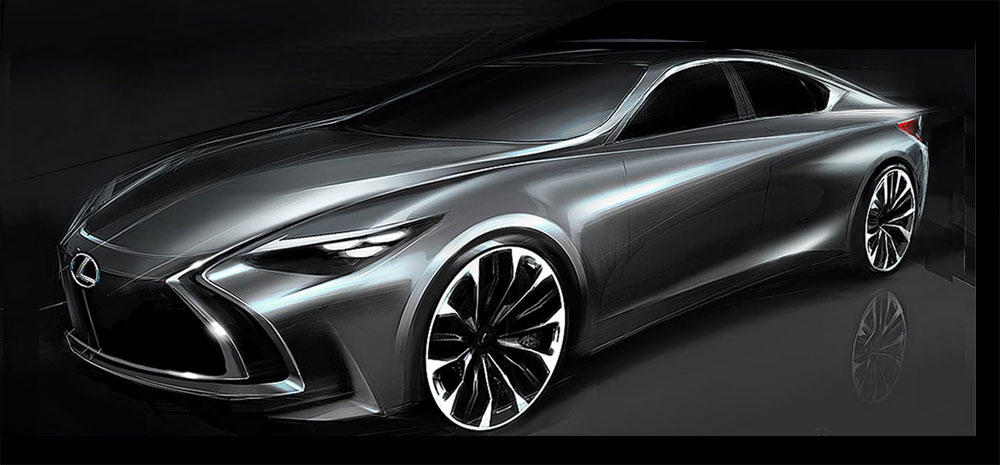


In front, the standard ES 350 & ES 300h have a grille of vertical bars that echo the design of the Lexus spindle grille:
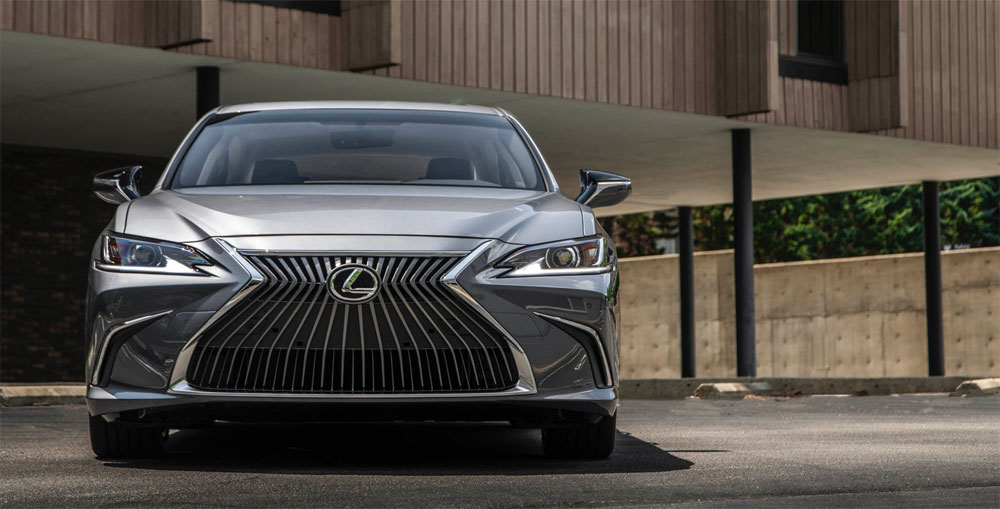
The side profile has a lower stance than the outgoing model, with a coupish angle similar to the LS flagship — Lexus calls this the “Human Centered Silhouette”:

We can rotate through the design of the ES, ES Hybrid, and ES F SPORT with this CGI video:
Platform
At the core of the seventh-generation ES sedan is the all-new GA-K platform:
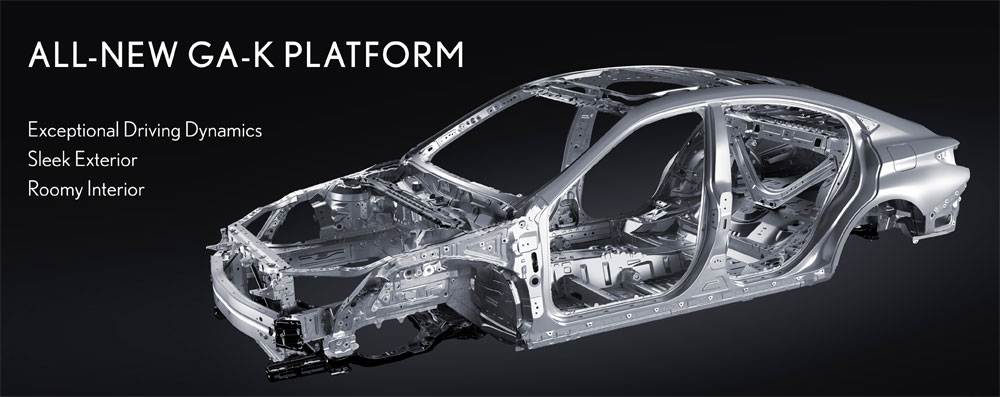
Compared to the current model, the new ES is longer by 2.6-inches, lower by 0.2-inches, and wider by 1.8-inches. The wheelbase has been extended by 2.0-inches, with the tracks widened by 0.4-inches in the front and 1.5-inches in the rear:
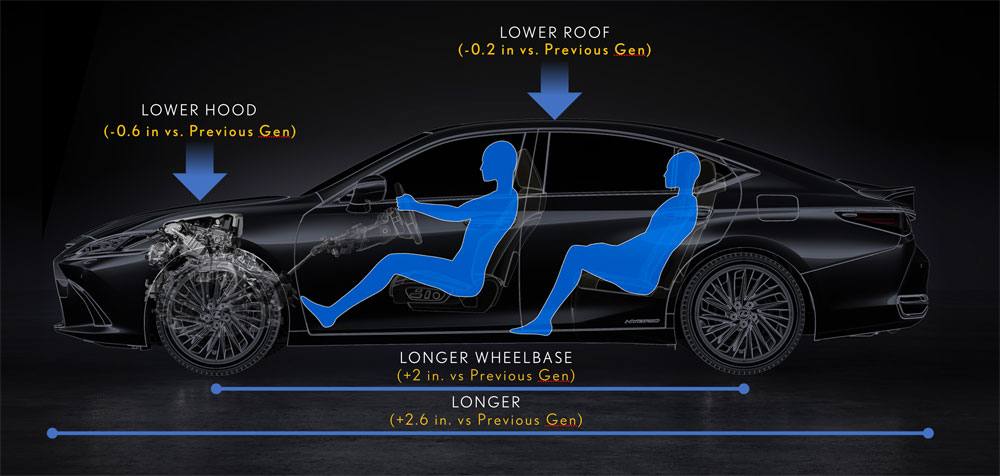
Here’s a short video illustrating the differences in size between the new ES and the current model:
Aerodynamics
The front bumper has been shaped to allow air to pass along the sides of the vehicle, while the aero stabilizing fins in the door frame molding and rear combination lamps improve stability — combined with the rear spoiler, the new ES can achieve a 0.26 co-efficient of drag:
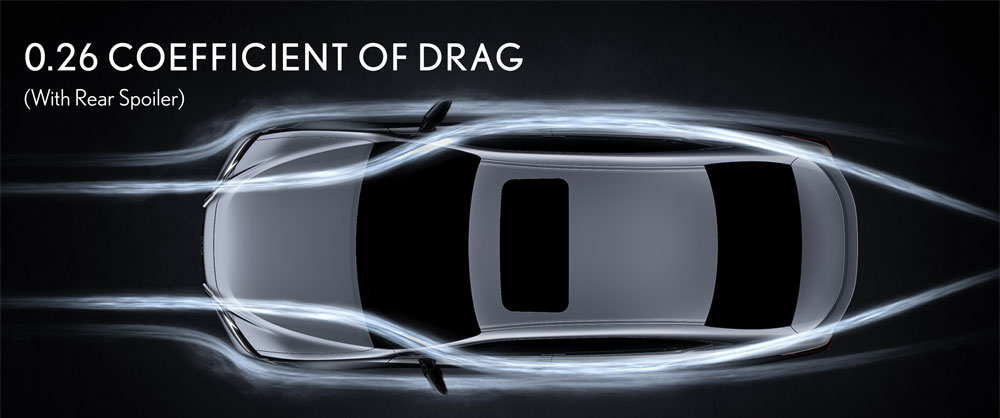
Lighting
The 2019 ES will come standard with bi-LED headlights with integrated LED daytime running lights:
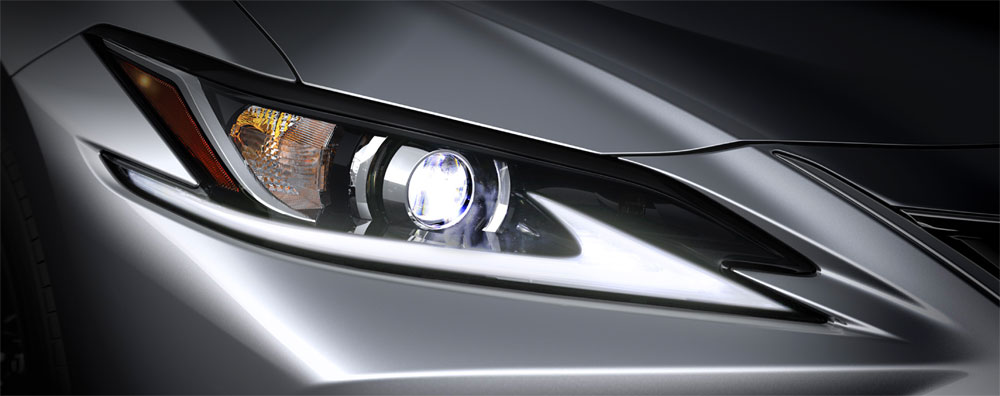
Available triple-beam LED headlamps use three compact bi-LED units and an adaptive front-lighting system that angles the lights based on steering input. LED turn signals and side marker lamps are also part of the upgrade:
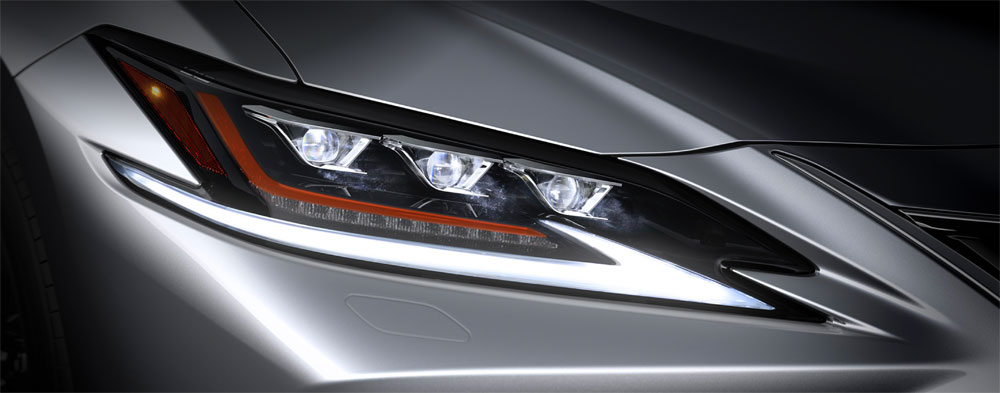
The full-LED rear combination lamps feature a three-dimensional layered L-shaped design:
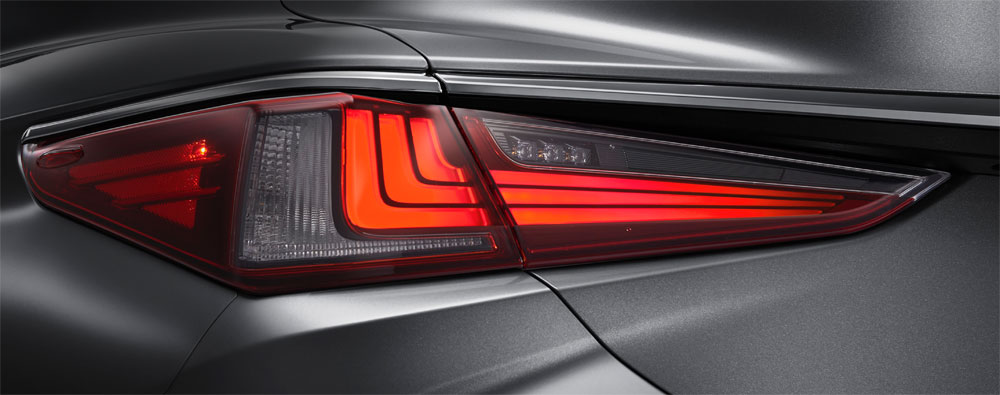
Panoramic Moonroof
A Panoramic Moonroof is an available upgrade, with a front glass panel that opens externally and slides to the rear:

A mesh wind deflector reduces wind noise when the front panel is open, and power-retractable shades help diffuse sunlight inside the cabin.
Wheels
The standard ES will be available with three wheel designs, including an available 18-inch noise-reducing wheel that uses a hollow section in the rim to resonate with the air in the tires, causing friction and converting sound waves to heat:

Hands-Free Power Trunk
Trunk space has increased by 1.5 cubic feet in the new ES, for a total of 16.7 cubic feet in both the gas & hybrid models. An available hands-free power trunk can be opened and closed by kicking under the rear bumper while carrying the smart key:
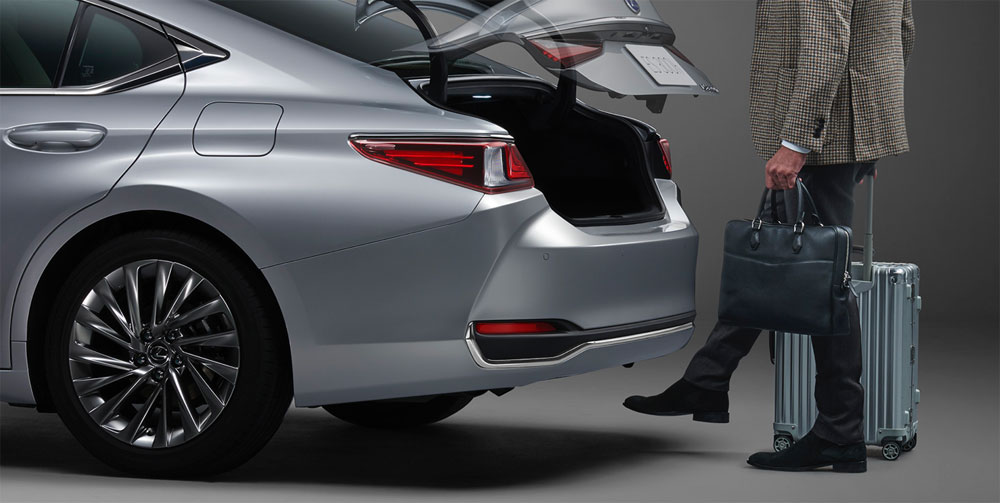
Exterior Colors
The ES 350 & ES 300h will be available in 10 different exterior colors:

They are, in order with their color codes: Eminent White (085), Silver Lining Metallic (1J4), Atomic Silver (1J7), Nebula Gray Pearl (1H9), Obsidian (212), Caviar (223), Nightfall Mica (8X5), Matador Red Mica (3R1), Sunlit Green (6X0), and Moonbeam Beige Metallic (4X8).
Interior Design
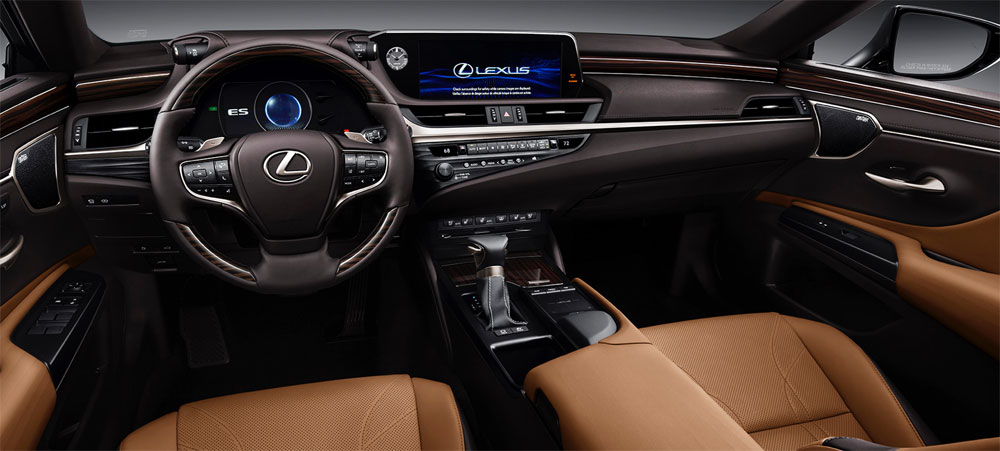
The ES interior is split into two distinct zones — the driver’s side (red) is centered on easy access to all functionality, while the passenger’s side (blue) is focused on comfort and much simpler in design:
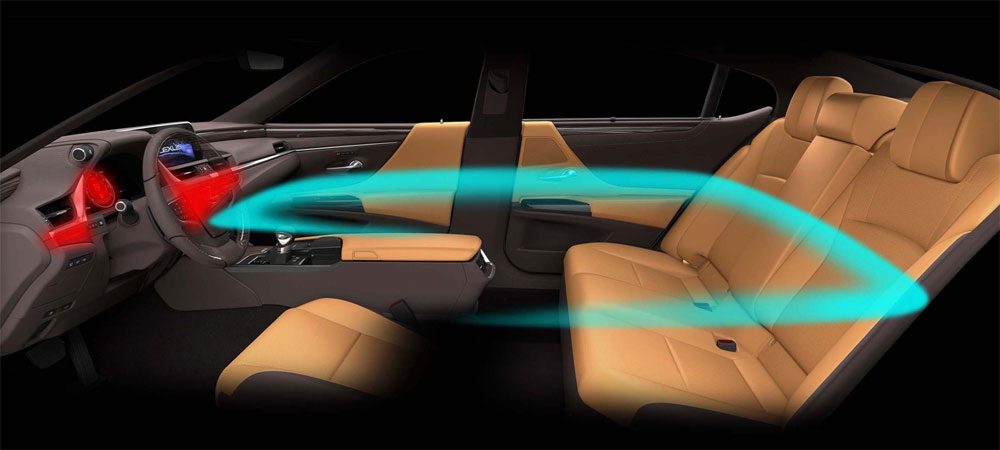
Seating
Like the LS flagship, the ES has a two-part seating design that aligns with the armrests:

With the lower vehicle profile, the seating position has been pushed down to improve driving visibility:
Standard are 8-way power front driver and passenger seats, with an available 10-way power driver’s seat that adds lumbar and cushion length adjustment. Rear passengers can expect 39.2-inches of legroom:
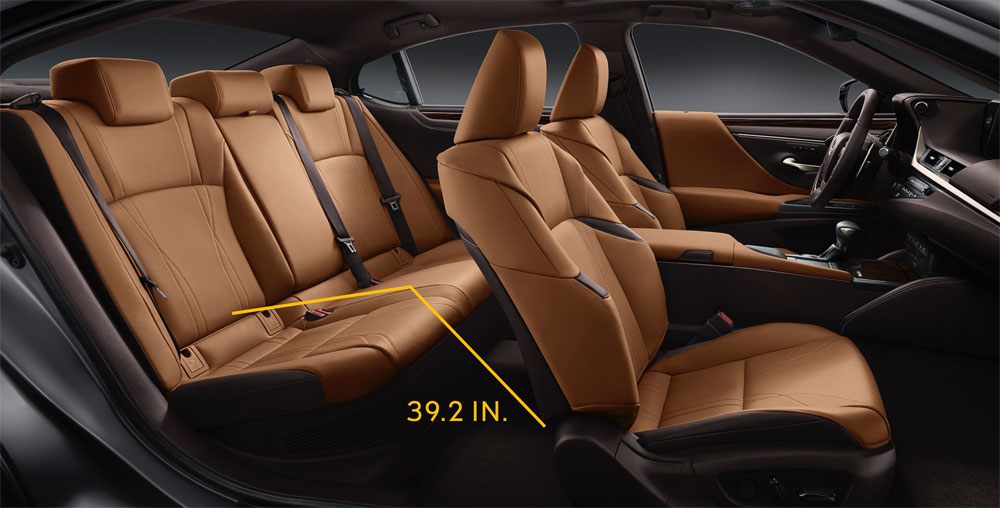
(Some markets outside of North America will get rear temperature controls along with adjustable seat backs — expect to hear more about that shortly.)
Steering Wheel
The 3-spoke steering wheel is shared with the new LS flagship, and like the LS, the optional heated steering wheel provides warmth to the entire rim. A steering touch sensor has also been integrated to accurately detect the driver’s grip while Lane Tracing Assist (LTA) is operating.
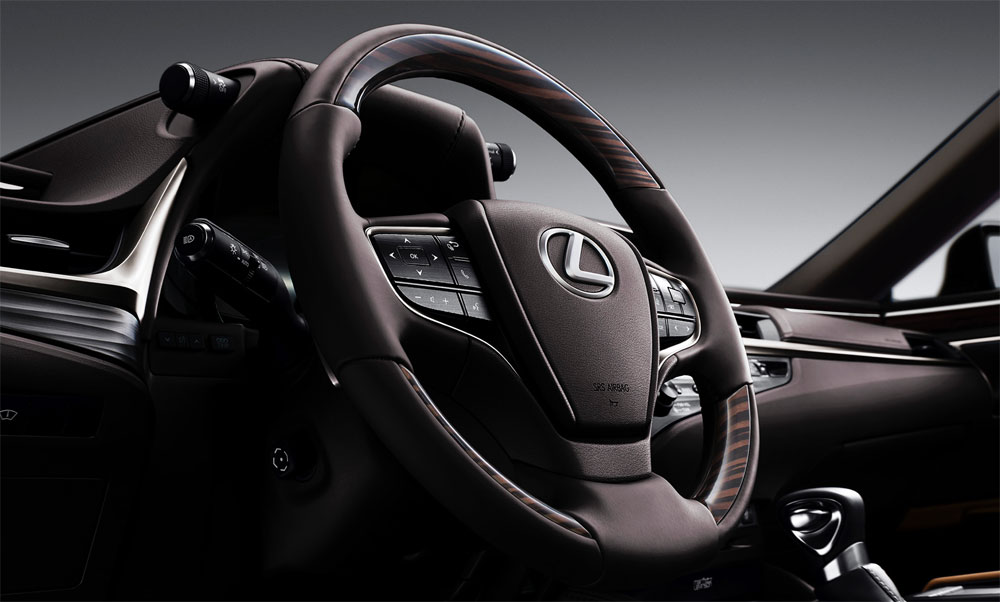
Interior Colors
There are three interior colors available with the ES 350 & ES 300h: Chateau, Flaxen, and Black. All three are offered in NuLuxe, leather (with the Luxury package), and semi-aniline leather (with the Ultra-Luxury package):
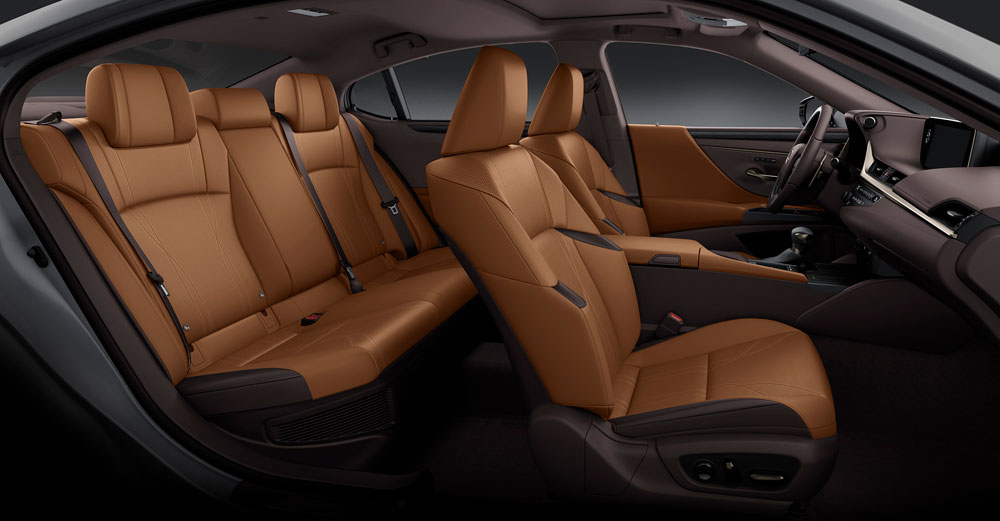
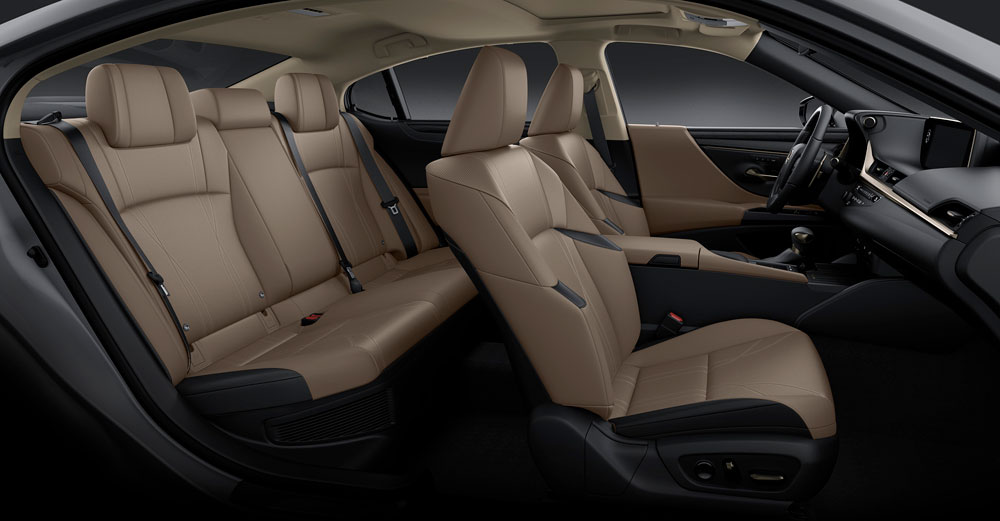
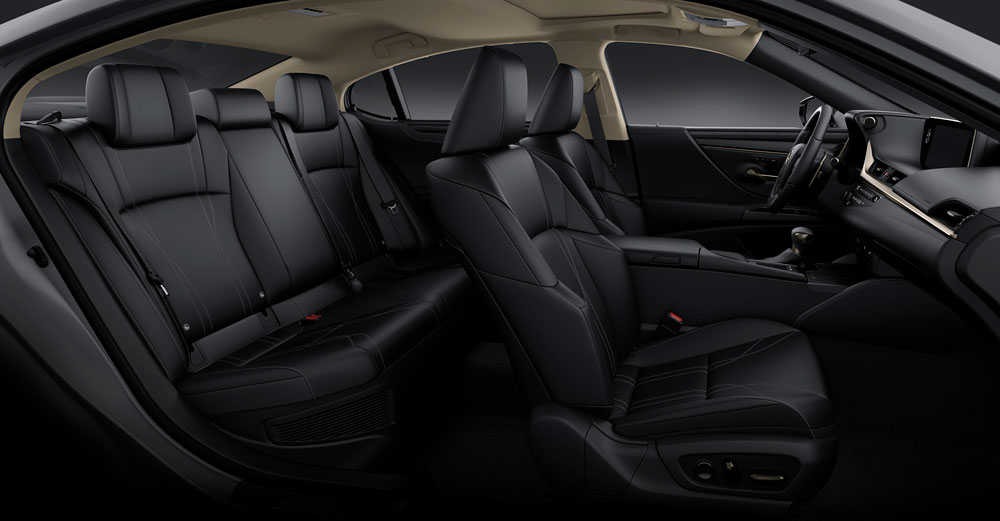
Striated Black is the standard trim, with Linear Dark Mocha wood, Linear Espresso wood, and Matte Bamboo available as options:
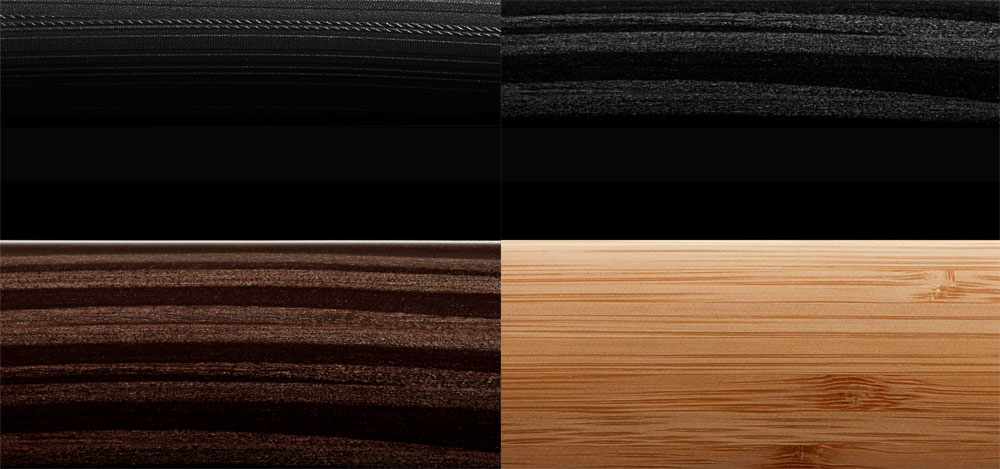
Meters & Instrumentation
The standard instrument panel features a 7-inch TFT LCD screen in a circular surround, with an additional multi-information display to the left of the main speed/tachometer display. Optitron-type meters are used for the water temperature and fuel gauges:
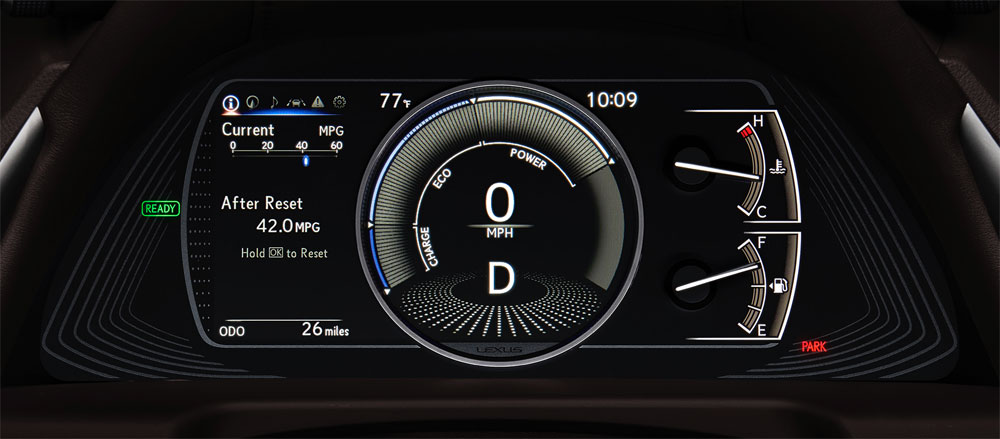
Heads Up Display
An available 10.2-inch color Heads-Up Display (HUD) displays a range of information onto the bottom of the windshield glass, including road speed, engine speed (rpm), gear selection, local speed limit, and other data relevant to the driver.
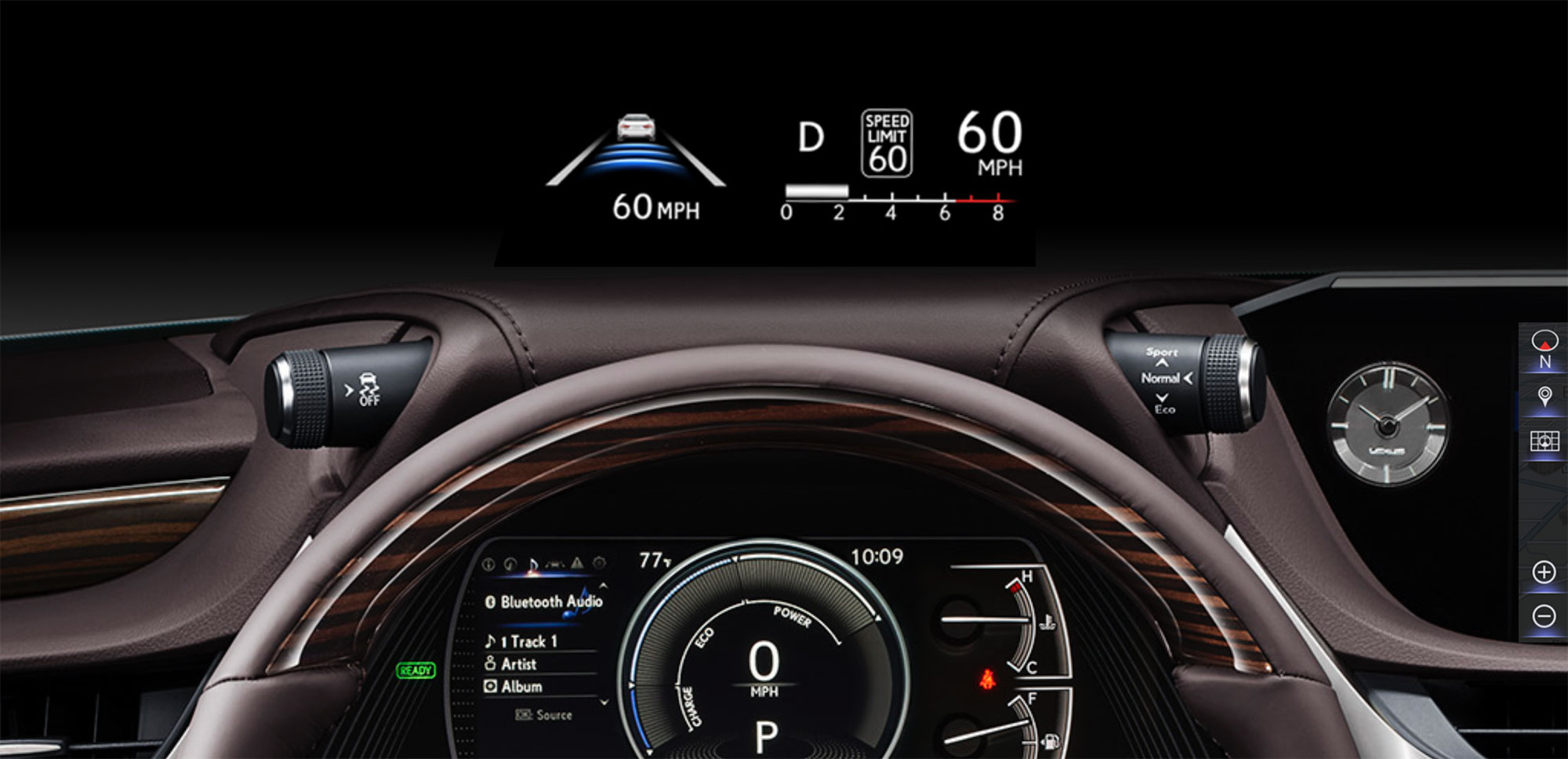
The Thin Film Transistor (TFT) backlit optical lens has a maximum brightness of 13,000 candela per square meter, and projects the image a virtual 8.2-feet ahead of the windshield.
Infotainment
A 12.3-inch multimedia display will be standard on all ES models, with navigation-equipped models offering dynamic directions by combining the on-board point-of-interest database with off-board (cloud-based) data:
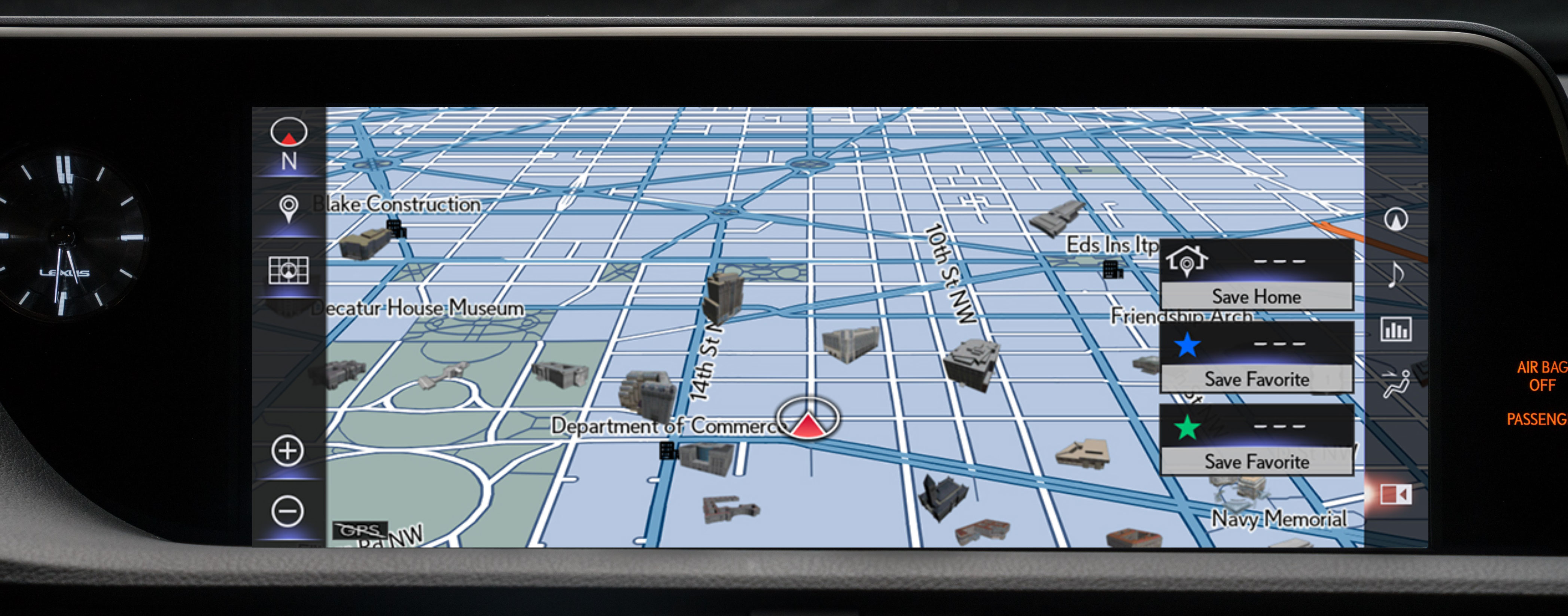
Apple CarPlay will be offered for the first time in a Lexus vehicle, making it easy for users to interact with iPhone-supported apps through the multimedia display. CarPlay will be available on navigation-equipped vehicles at launch, with non-navigation-equipped vehicles getting the functionality after October 1st:
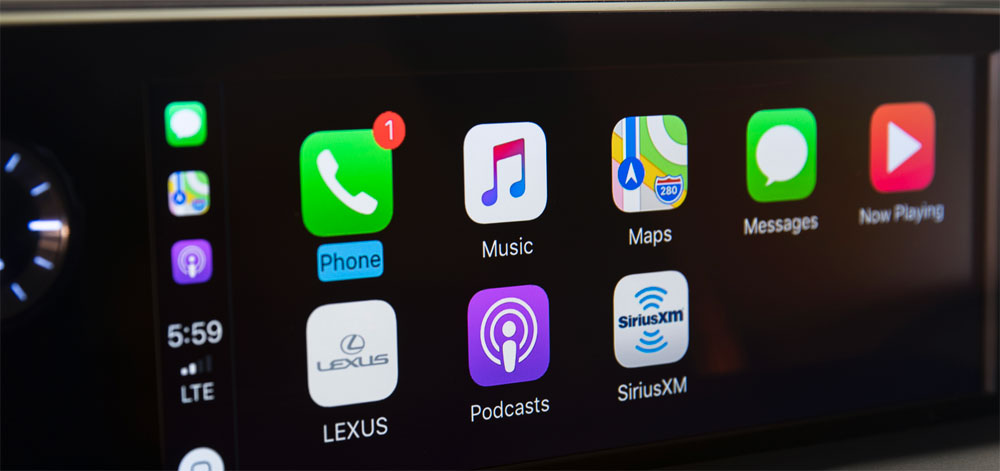
In addition to CarPlay, the ES will be the first Lexus model to offer in-car access to the Amazon Alexa voice service — here’s a video detailing the functionality:
(The service will be available on Android devices at launch, with iOS following later in the fall. Some Amazon Alexa features will require an ES equipped with the Navigation system and an active subscription to Lexus Enform. )
A Qi-compatible wireless smartphone charger is an available option:
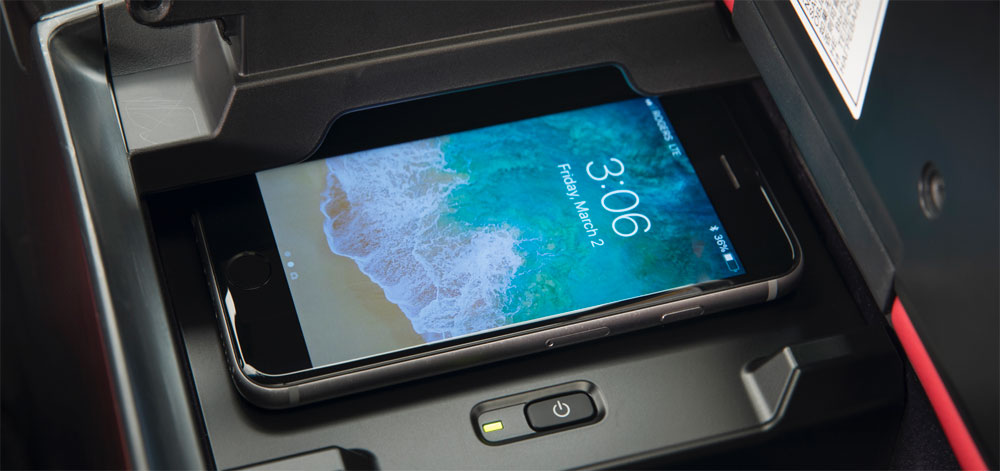
Climate Controls
The North America-spec ES will feature two-zone automatic climate control using toggle-switches in the upper dash:
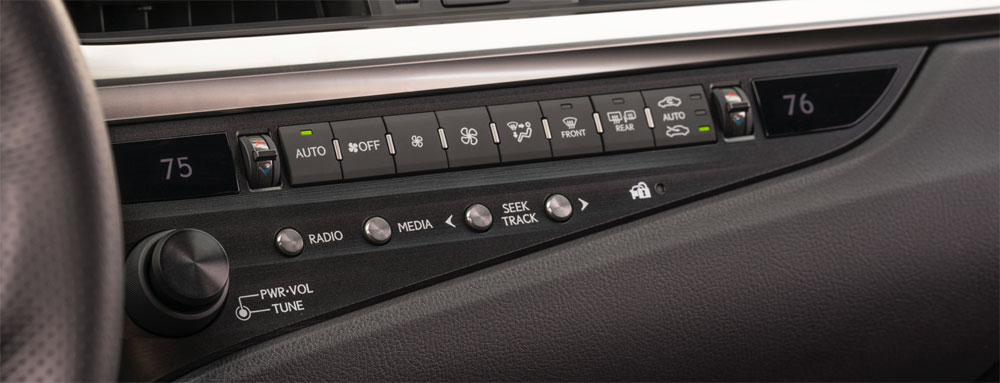
Lexus Climate Concierge is available for the first time in the ES — when activated, the system combines seat heating, HVAC and steering wheel heating (if equipped) to achieve the driver’s selected temperature.
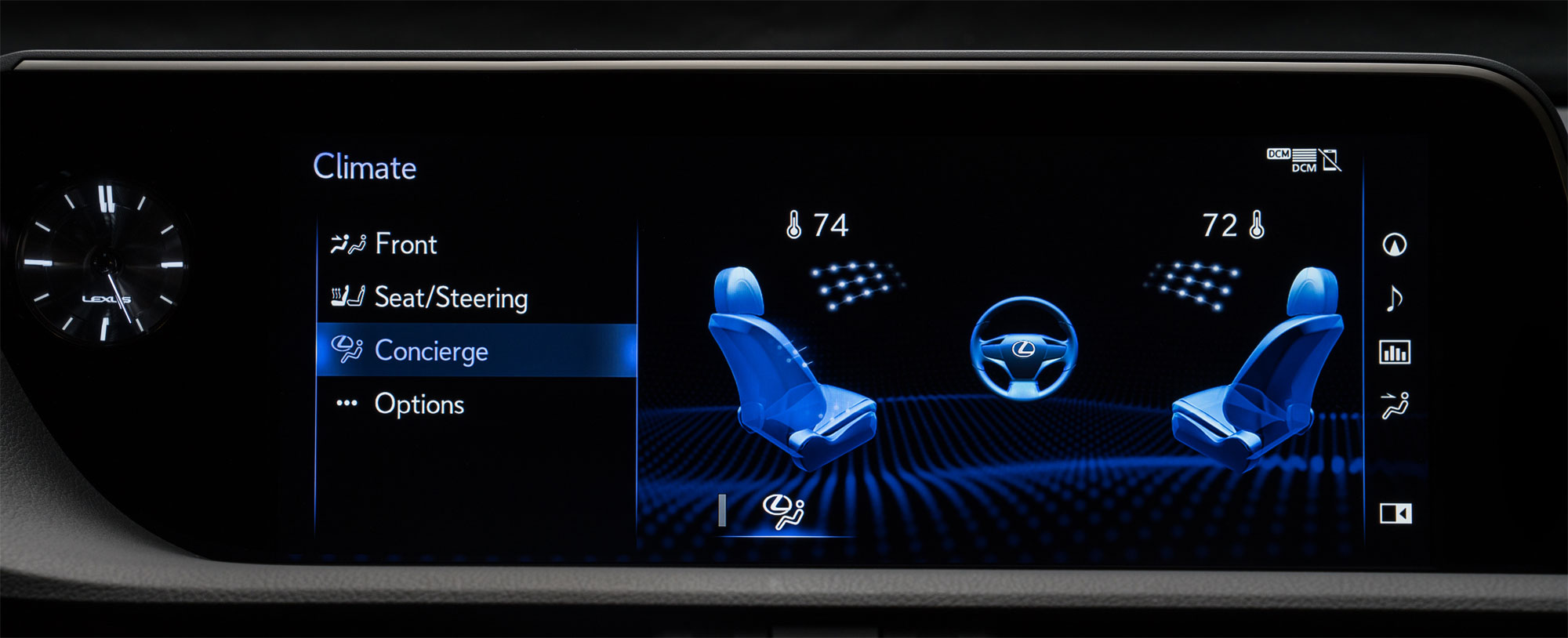
Interior Illumination
LEDs are used for all interior illumination, with special attention given to nighttime ambient lighting:
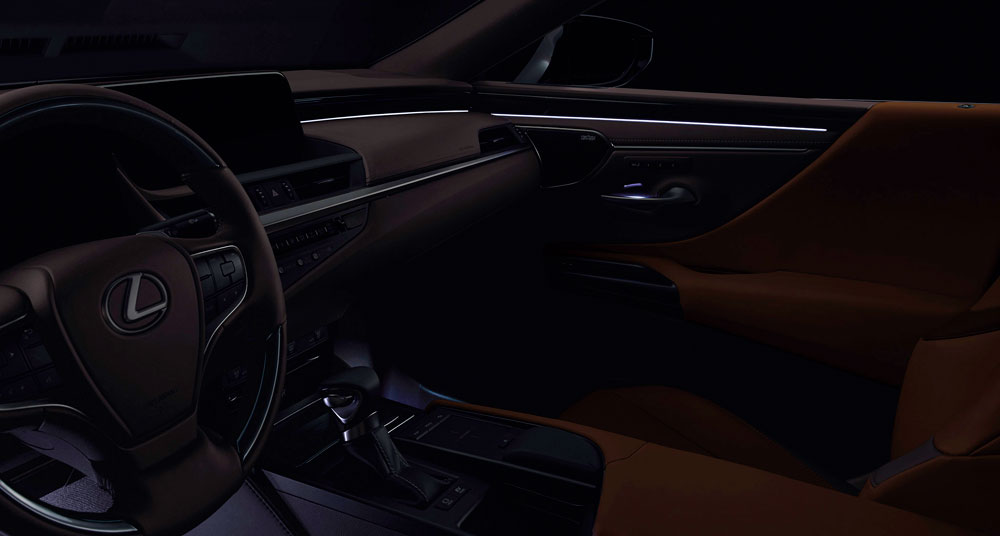
Sound Systems
An 8-channel 10-speaker Pioneer audio system with a 296 W amplifier is the standard kit:
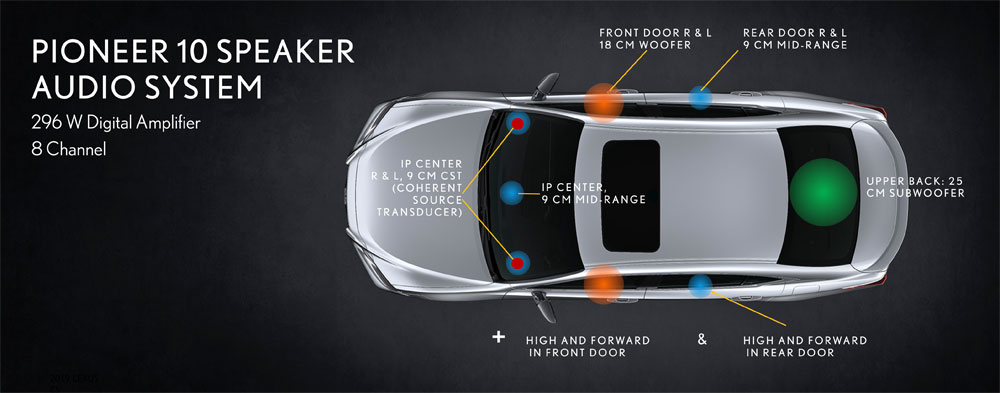
The audio upgrade comes in the form of a 12-channel 17-speaker Mark Levinson surround sound system with a 1800 W digital amplifier:
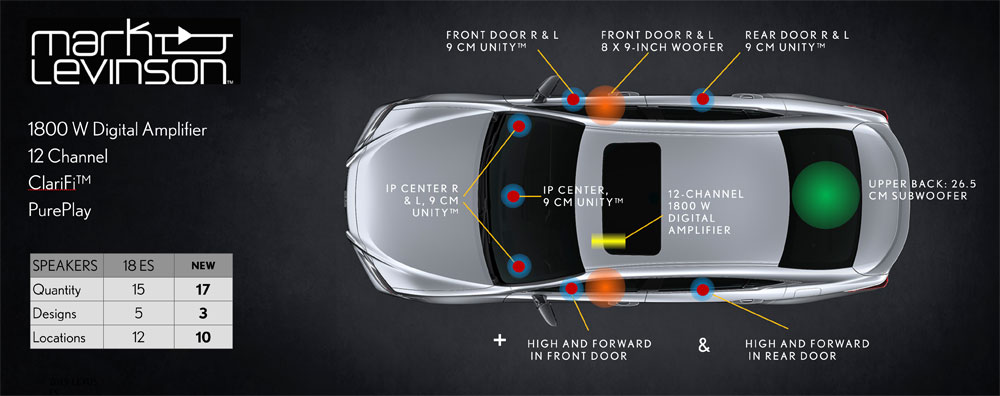
ES 350 Powertrain
Under the hood of the 2019 ES 350 is a 2GR-FKS 3.5-liter Atkinson cycle V6 with intake VVT-iW and exhaust VVT-i, rated at 302 horsepower @ 6,600 rpm and 267 lb.ft. of torque @ 4,700 rpm:
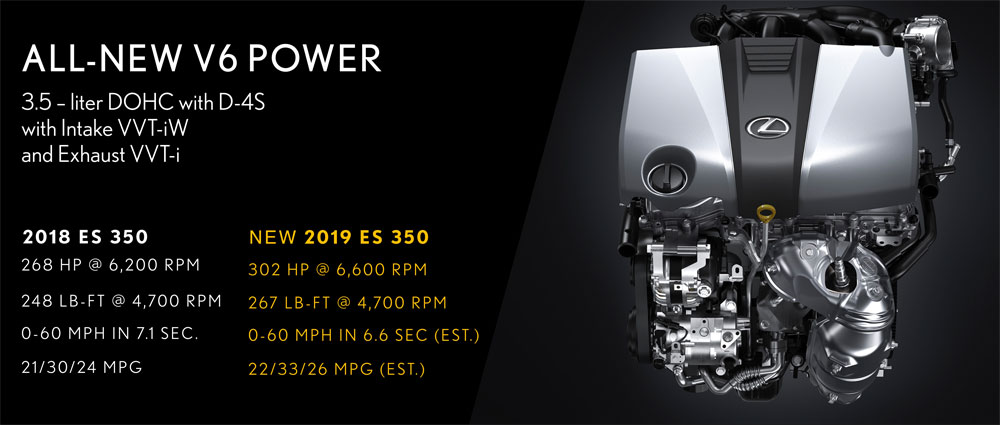
The 0-60 time is an estimated 6.6 seconds, with an manufacturer-estimated fuel economy (US MPG, city/highway/combined) of 22/33/26 for the ES 350 and 22/31/25 for the ES 350 F SPORT when running the recommended 87 octane fuel.
The ES 350 V6 is paired with a Direct Shift-8AT automatic transmission with a newly developed torque converter and multi-plate lock up clutch that Lexus claims has “has the direct feel of a dual clutch design along with the off-the-line smoothness of a traditional torque converter automatic”:
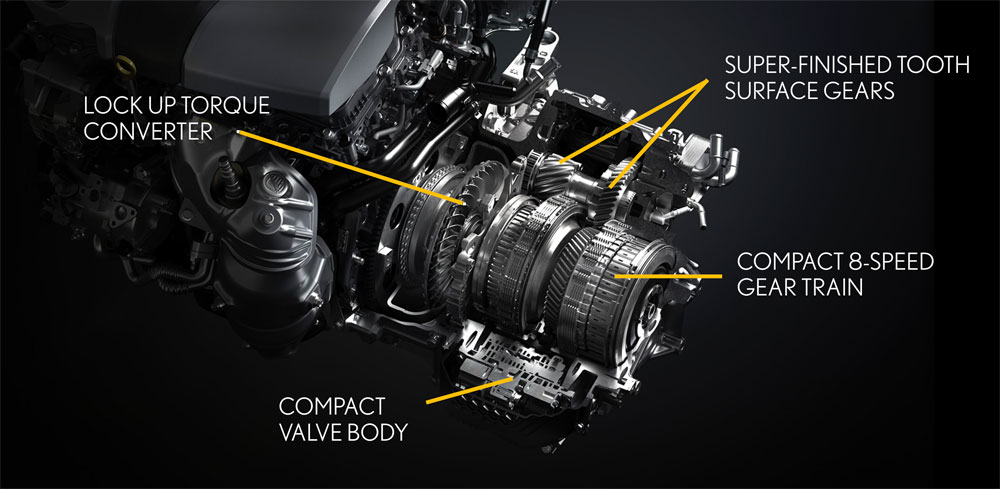
The 8-speed Direct Shift transmission has a wider range of ratios designed to return improved mileage and more responsive performance:

ES 300h Powertrain
The gasoline portion of the ES 300h is the new A25A-FXS 2.5-liter DOHC direct injection Atkinson cycle 4-cylinder with intake VVT-iW and exhaust VVT-i, an engine that was a WardsAuto 10 Best Engines winner in the Toyota Camry Hybrid. It’s rated at 176 horsepower @ 5,700 rpm, for a total of 215 horsepower when combined with the hybrid tech:
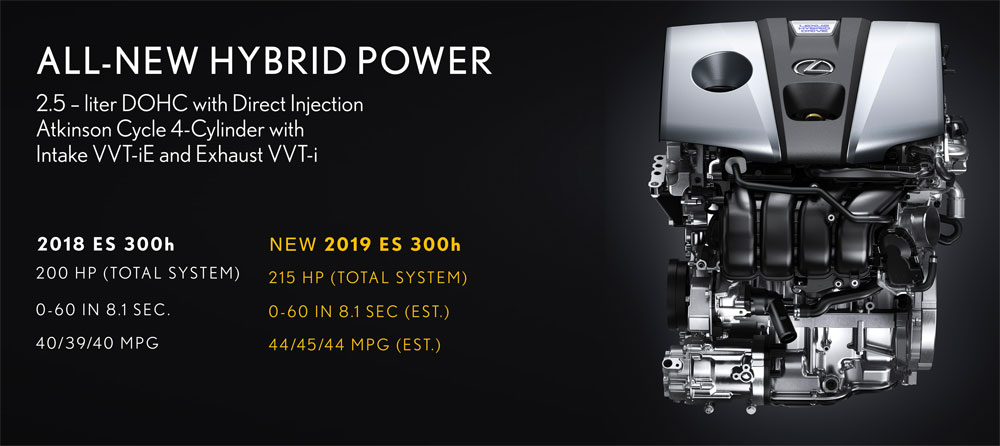
The manufacturer-estimated fuel economy (mpg, city/highway/combined) for the ES 300h is 44/45/44 mpg using the recommended 87 octane fuel. The hybrid system can now deactivate the gas engine at speeds up to 75 mph (120 km/h), up from the previous system that was limited to 47 mph (75 km/h).
By reducing the size of the control circuit board and developing a new power stack, Lexus engineers have made the ES 300h Power Control Unit (PCU) 9% smaller and 22% lighter than the previous model — this allows the PCU to be mounted immediately above the transaxle:
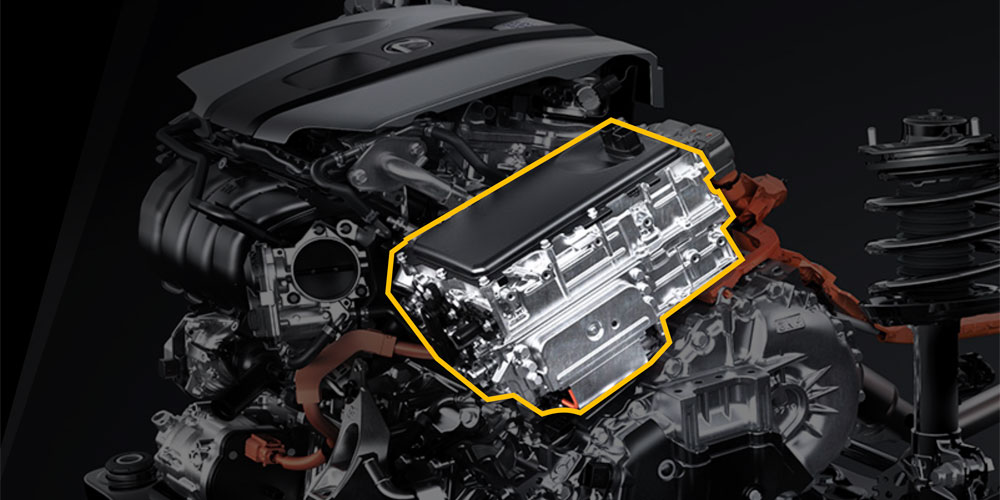
An all-new hybrid transaxle switches from coaxial arrangement of MG1 (power generation) and MG2 (drive) to a multi-axial arrangement, reducing overall length by 30mm and overall weight by 15%. The improved design also benefits from a change to a parallel shaft gear in place of the conventional planetary gear:

The size of the nickel-metal hydride battery has been reduced, allowing it to be placed under the rear seats instead of the trunk — this increases the ES 300h’s trunk space to match the gas-powered model, while optimizing weight distribution and lowering the vehicle center of gravity:
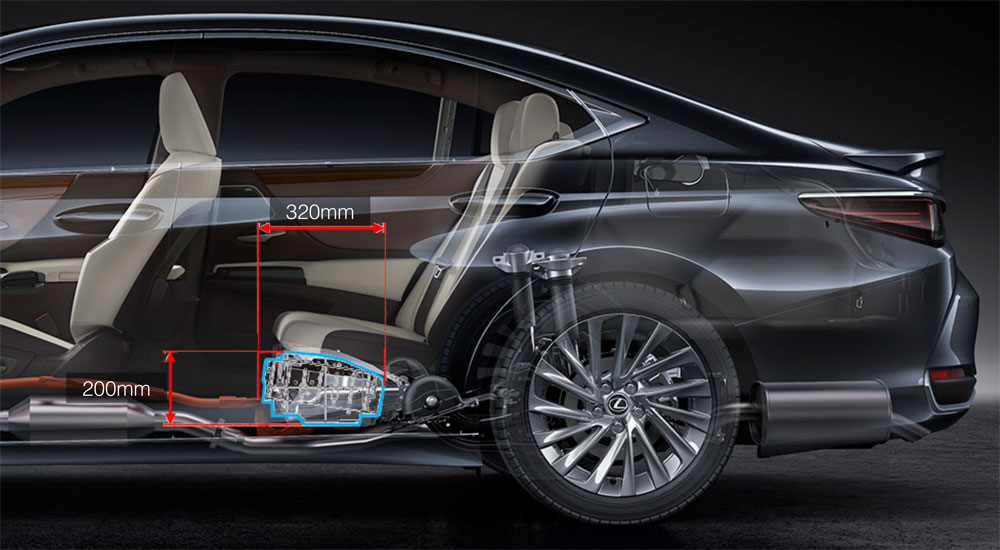
Auto Glide Control
Engineers have added something called Auto Glide Control to the ES 300h ECO mode that can automatically decelerate at a level comparable to coasting in neutral — in effect, built-in hypermilling functionality:
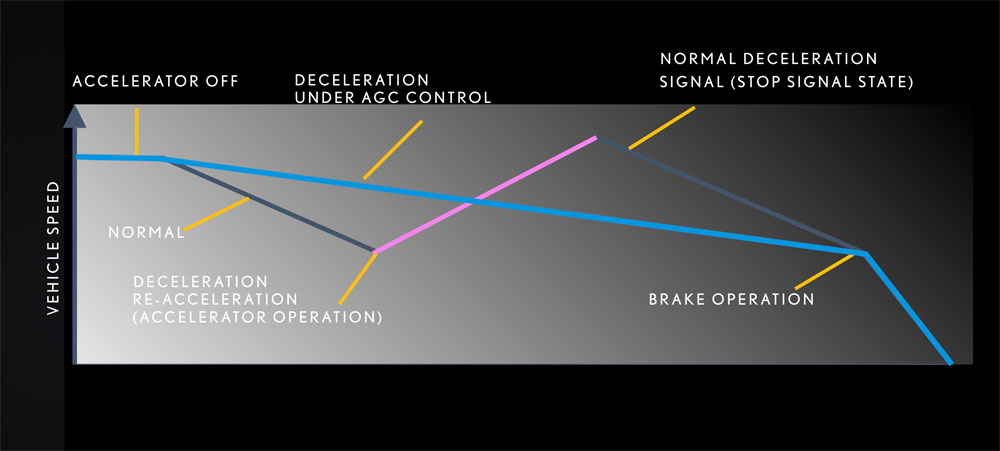
Suspension & Chassis
The ES uses a MacPherson strut front suspension and a multi-link rear suspension with integrated trailing arm, both using newly developed Dynamic Control Shocks:
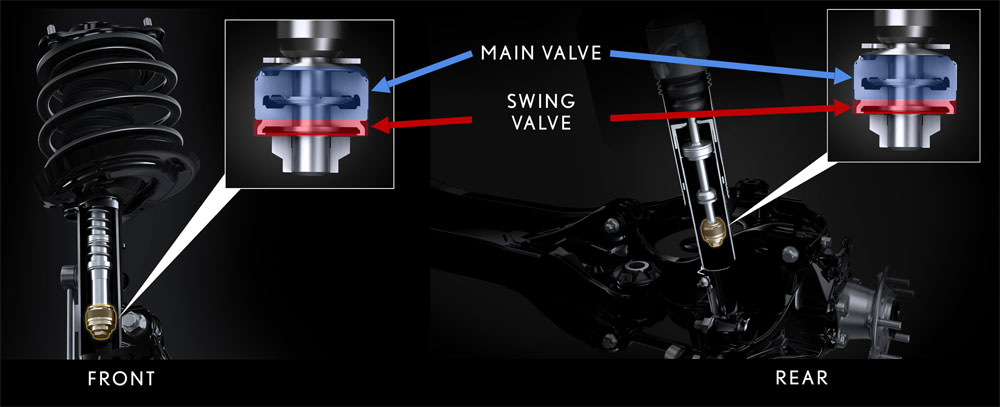
Dynamic Control Shocks generate a damping force with a non-overlapping auxiliary valve that allows damper oil to flow in either direction before entering the main valve. This action can absorb the feedback from rougher roads and smooth out the overall ride.
A new 4-point engine mounting system has utilized, with front and rear mounts installed to a vibration-dampening sub-frame, while the right and left mounts are installed to side members:
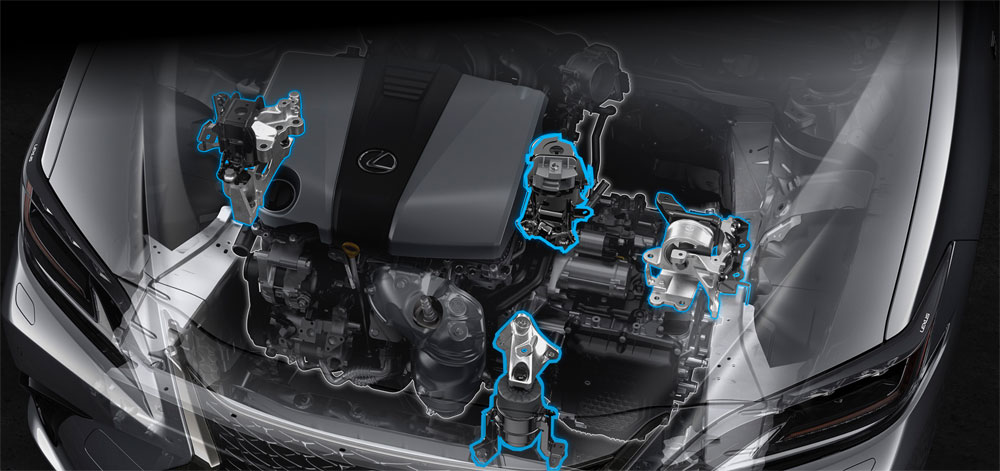
Vacuum-controlled hydraulic engine mounts are used for the front and rear mounts on V6 models, which allows for variable dampening depending on driving conditions.
The new ES is approximately 137 pounds (62 kg) lighter than the current model due to the greater use of lightweight materials and thinner outer panels:
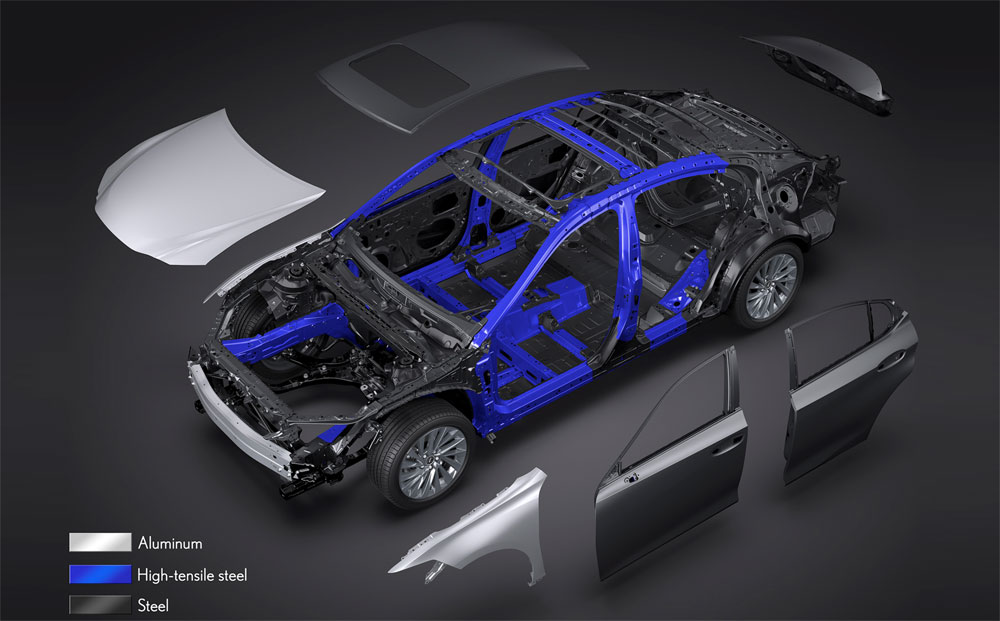
To improve rigidity, Lexus engineers included a closed cowl and suspension tower brace, a ring structure with a V-brace that reinforces the area behind the rear seats, and a spot welded gusset to join the roof crossmember and outer rail:

A total of 65 ft. (19.94m) of structural adhesive and 160 laser screw welds have been used throughout the new ES to improve overall rigidity:
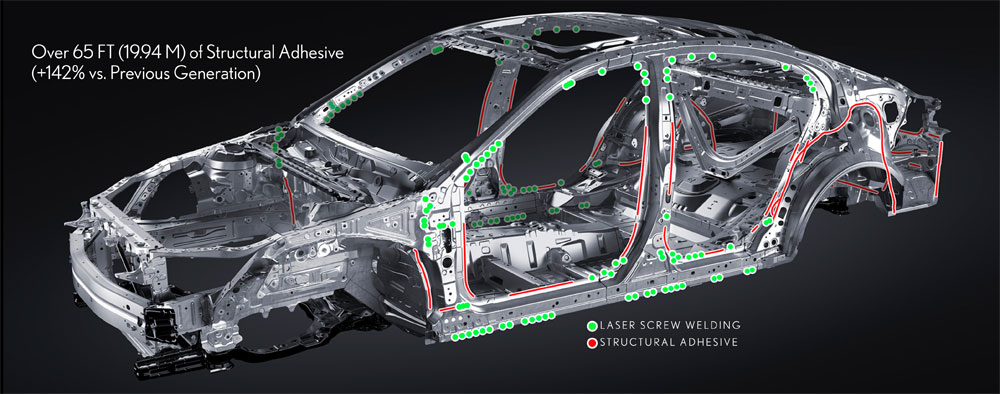
The interior and exterior of the floorboard has been coated with sound dampening materials, bringing the noise reduction up to 93% from the 75% rating of the previous generation:
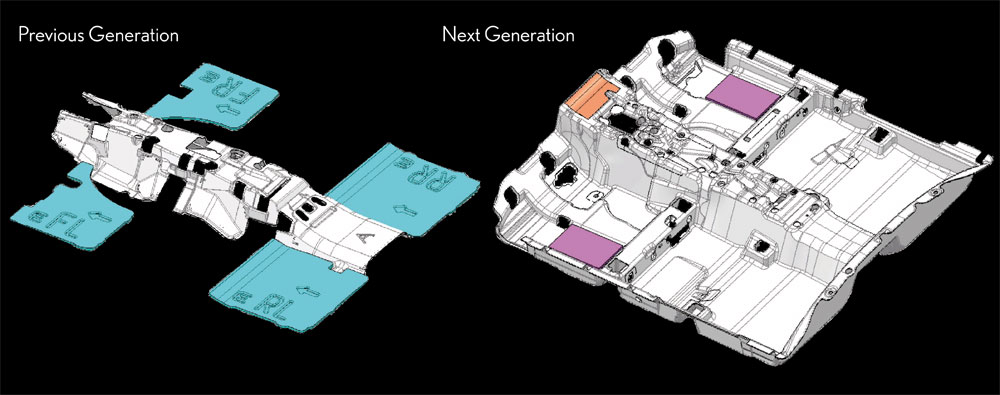
The ES 300h hybrid gets additional padding at the firewall designed to absorb and reflect typical hybrid sounds:
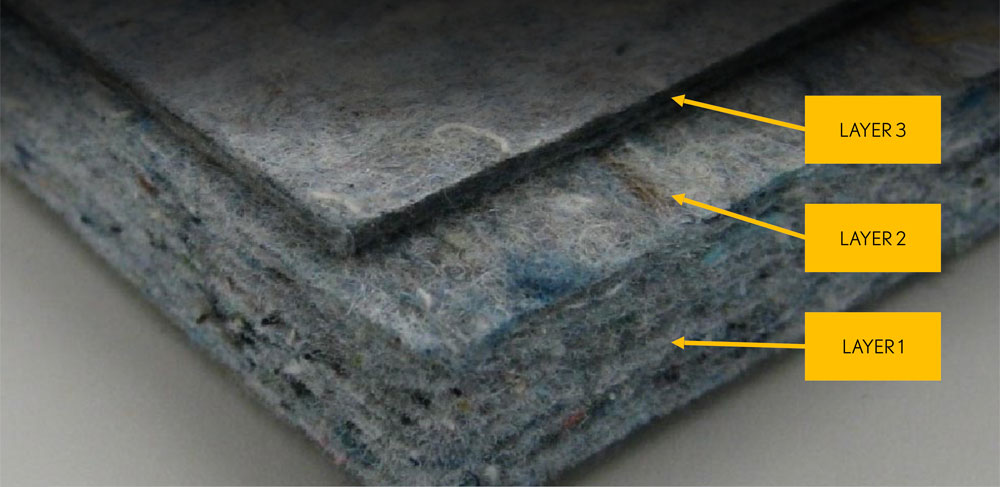
Included with the Ultra Luxury and F SPORT packages are performance dampers at the front and rear of the vehicle, which absorb energy from the chassis for improved handling stability and ride comfort while reducing noise from vibration:
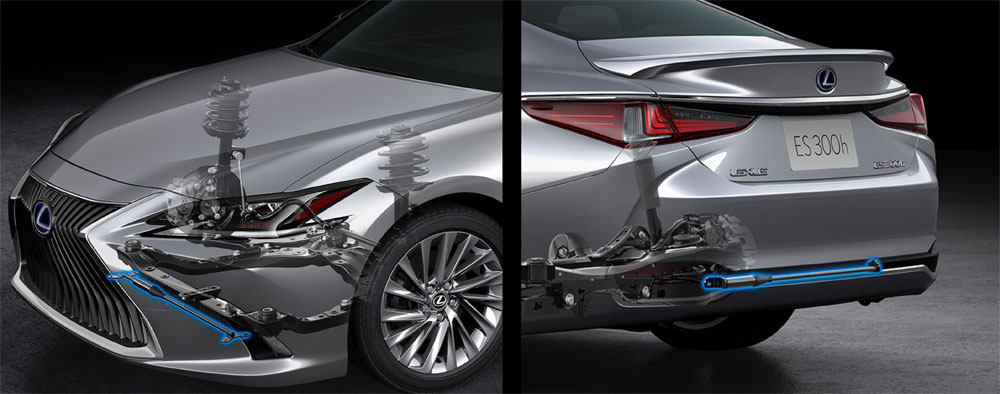
Brakes
Every model shares the same standard 4-wheel disc brakes with ventilated front and solid rear discs, measuring as such:
- Front: 12.01 inches (305mm) x 1.10 inches (28mm)
- Rear: 11.06 inches (281mm) x 0.47 inches (12mm)
Safety
The ES will debut the new Lexus Safety System + 2.0, which borrows from the advanced technologies introduced with the LS flagship — here’s a comparison with the previous safety suite:
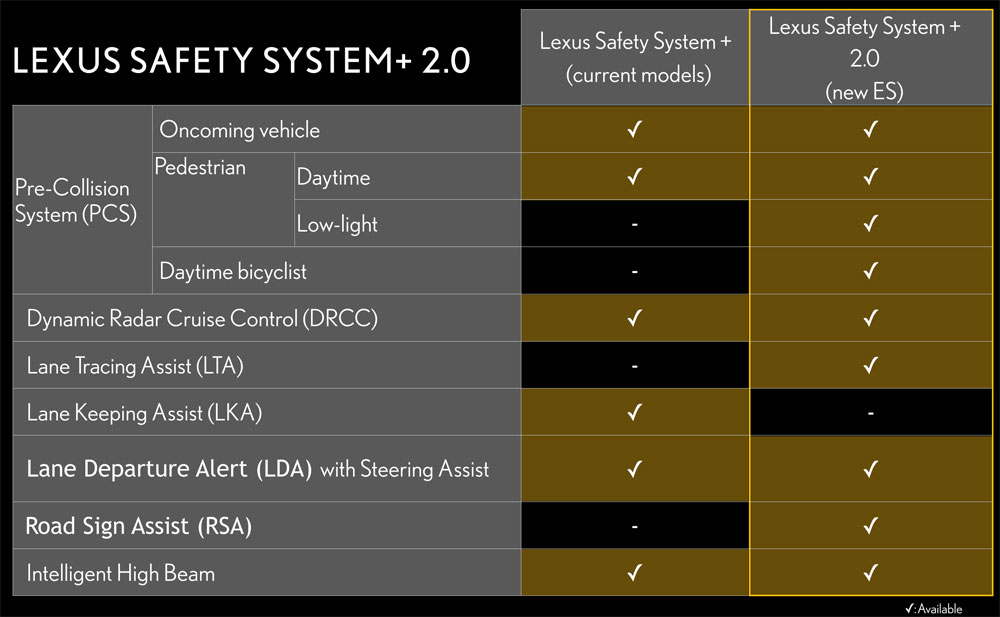
Many of these safety features have been covered in great detail previously, so let’s focus on newer technologies like Lane Trace Assist:
The Pre-Collision System now includes nighttime pedestrian and daytime bicyclist detection, and Road Sign Assist uses the front camera to detect road signs and display them on the multi-information display and Heads-Up Display:

All-Speed Dynamic Radar Cruise Control
The ES now includes All-Speed Dynamic Radar Cruise Control (DRCC) that will maintain vehicle-to-vehicle distance all the way to a stop:
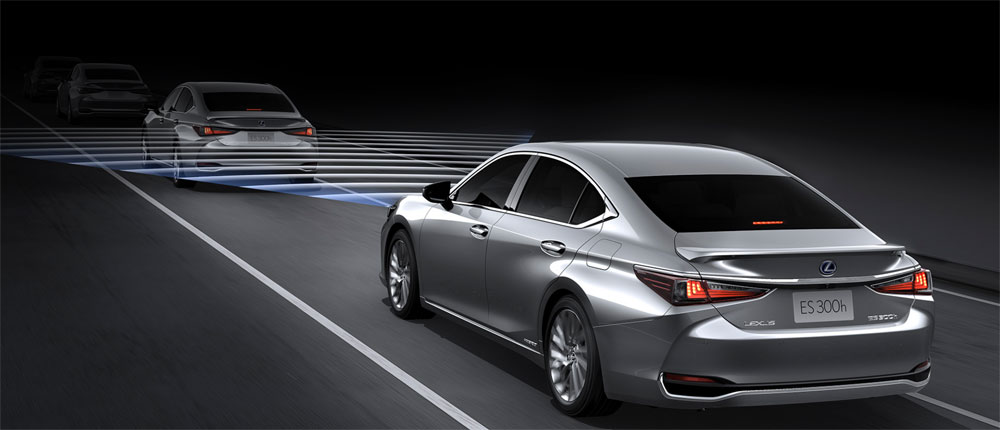
DRCC also includes a new feature called “blinker-linked” control — when following a vehicle traveling slower than the set speed, signaling a lane change will initiate acceleration to assist with passing. This kicks in at speeds of 70 km/h (44 mph) or greater, and will not activate if there is a car in the passing lane.
Panoramic View Monitor
Also available is the Panoramic View Monitor, which displays the ES surroundings on the multimedia display by using cameras installed the front, the left and right outer mirrors, and the rear:
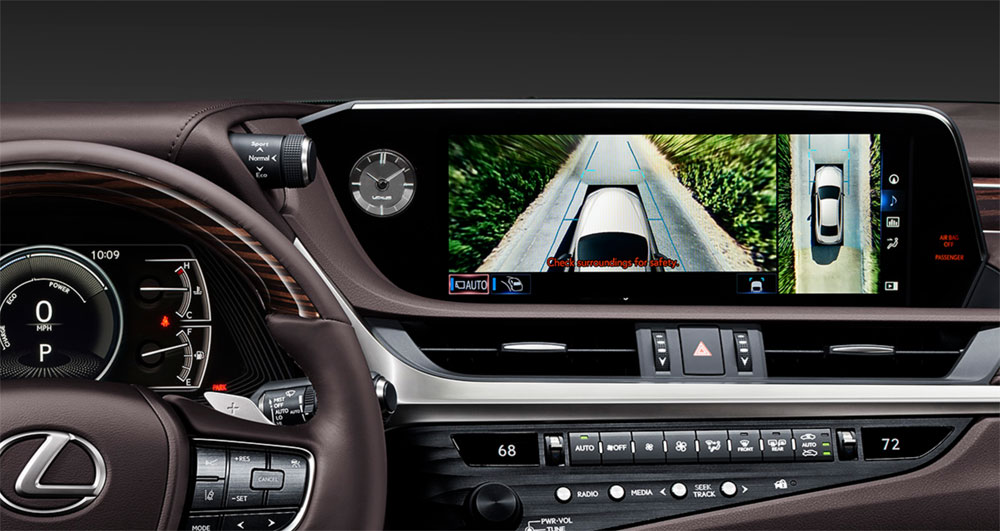
There are five different modes to choose from:
- Panoramic and Wide Front View provides a 180-degree view ahead of the vehicle using the front camera.
- Panoramic and Side Clearance View uses images from the front & side cameras to show the vehicle from above and behind.
- Panoramic and Cornering View displays an image from the rear of the vehicle to assist while cornering.
- See-Through View is a rotating eye-level view around the car, as if the ES was fully transparent.
- Moving View displays a rotating bird’s eye image.
Finally for safety, there are 10 standard air bags inside the ES:
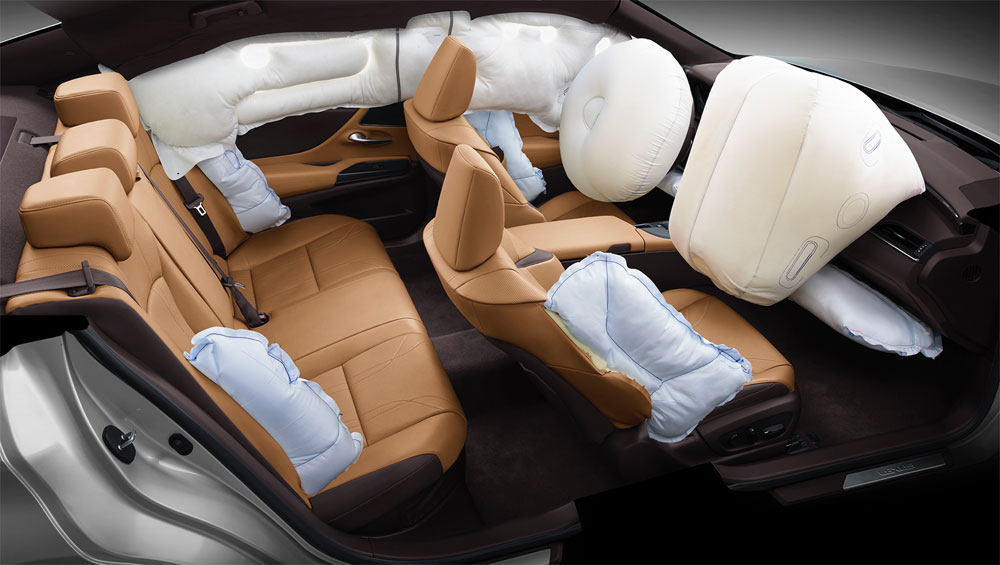
F SPORT Package
Starting with the exterior, the ES F SPORT features a mesh front grille with a black chrome surround:
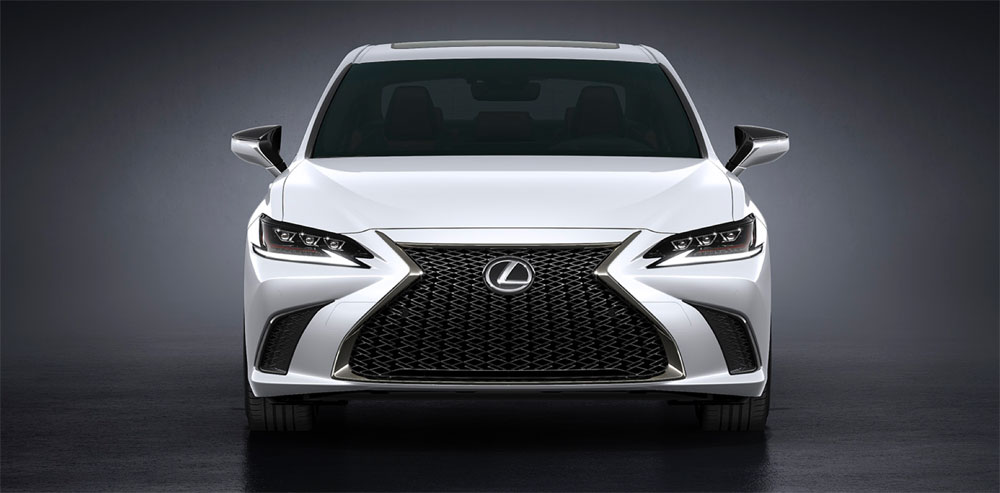
The black chrome accents continue to the rear trunklid, which also includes a standard rear spoiler:
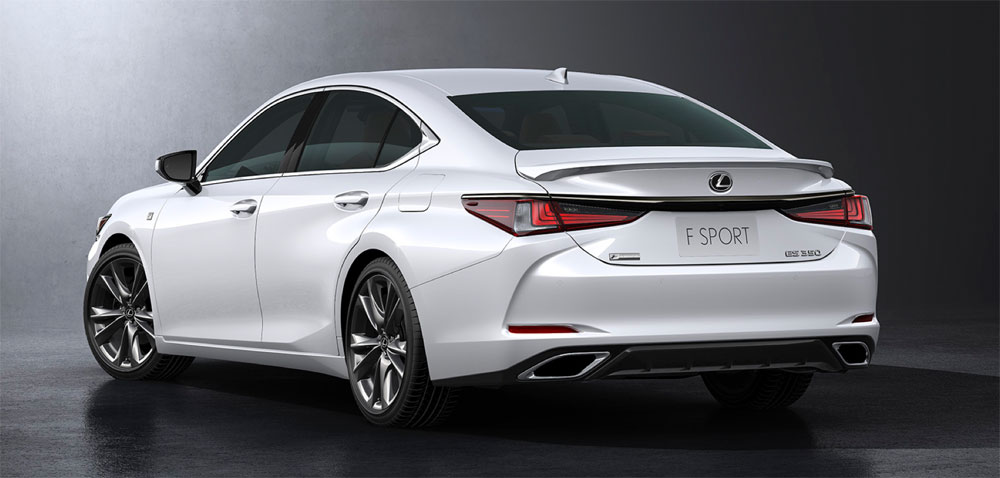
The F SPORT package includes 19-inch cast alloy wheels with a 235/40R19 tire:
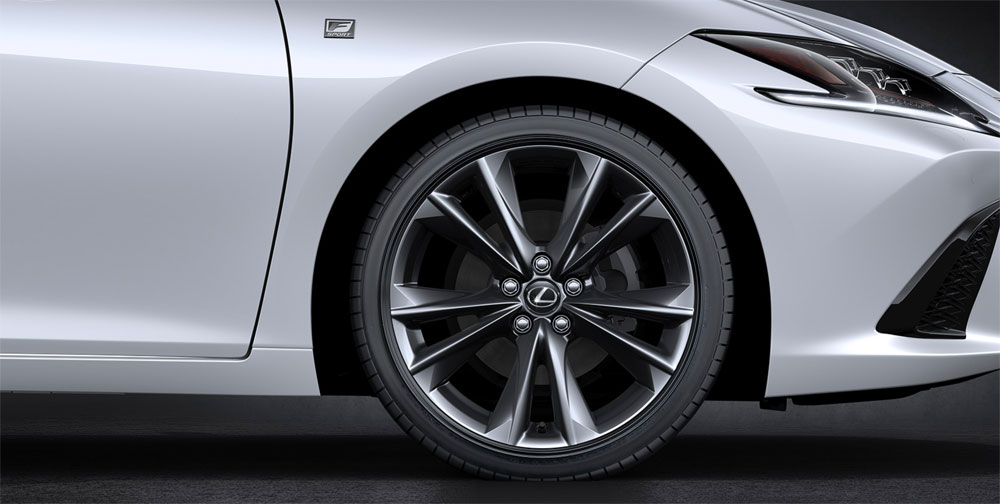
There will be eight color choices with the ES F SPORT:
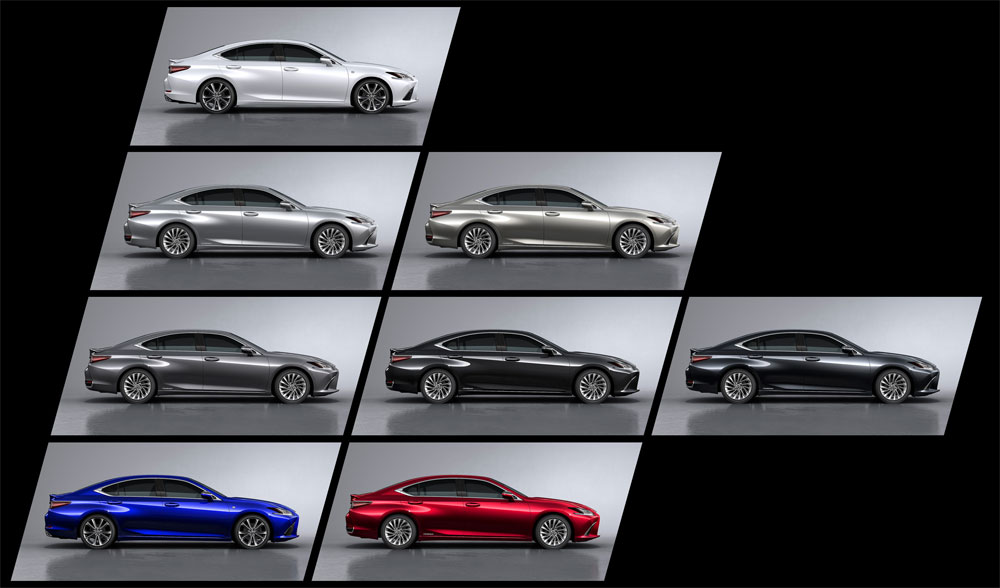
They are, in order with color codes: Ultra White (083), Silver Lining Metallic (1J4), Atomic Silver (1J7), Nebula Gray Pearl (1H9), Obsidian (212), Caviar (223), Ultrasonic Blue Mica 2.0 (8X1), and Matador Red Mica (3R1).
Adaptive Variable Suspension
Lexus has included an Adaptive Variable Suspension (AVS) with the ES F SPORT package, which controls the damping force of the shock absorbers on all four wheels in response to driving operations and road surface conditions:
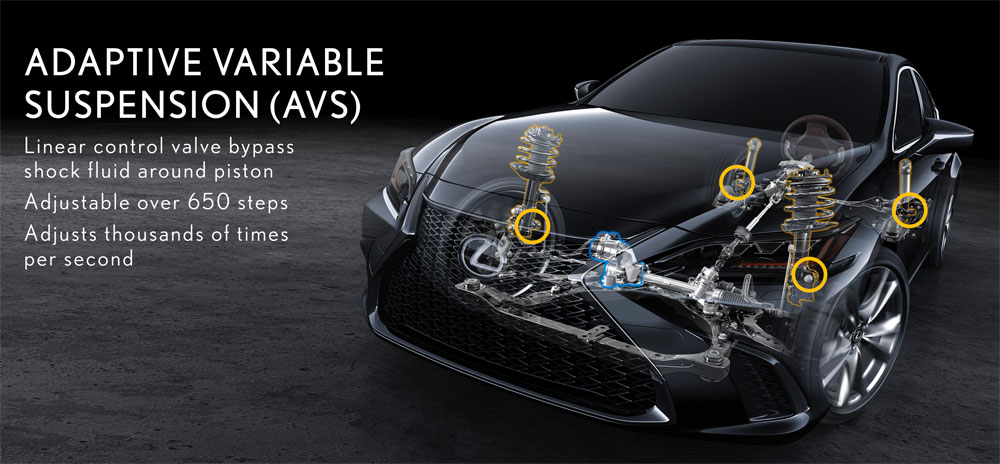
Interior Design
Inside, the ES F SPORT feature the same perforated leather steering wheel found in the LS F SPORT & LC coupe:
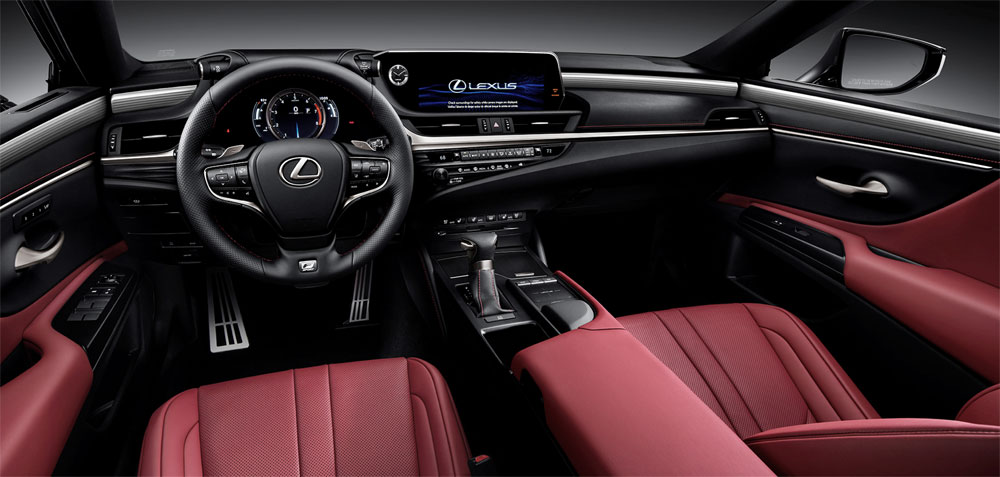
The 8-inch TFT instrument cluster with movable ring is the same design shared with all Lexus F SPORT models:

The front seats in the ES F SPORT are inspired by the optional performance seats in the LC coupe:
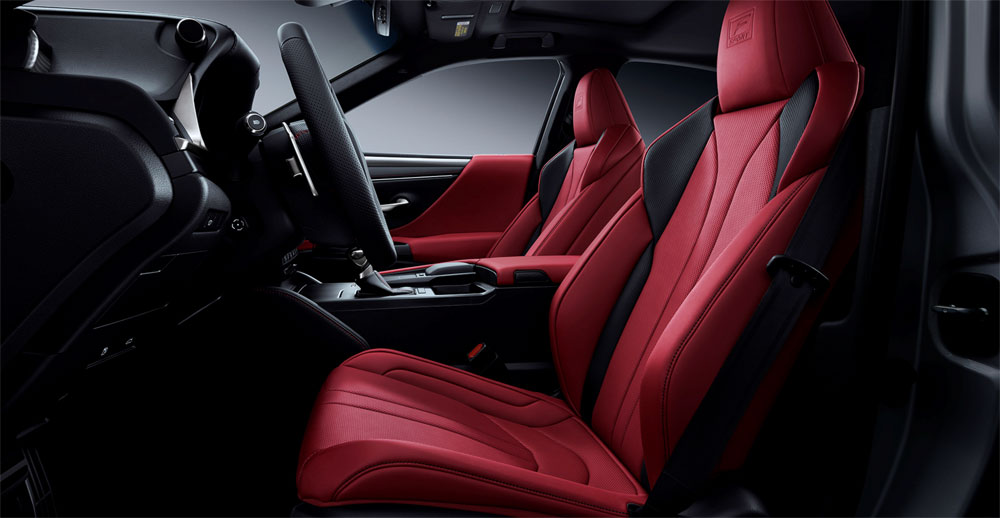
Unlike a traditional seat where a molded foam pad is covered with upholstery, the ES F SPORT seat shell is set into the mold and then filed with foam — this allows for a more aggressive design that provides better lateral support.
Interior Colors
For interior colors, there’s a choice between either Black or Circuit Red NuLuxe:
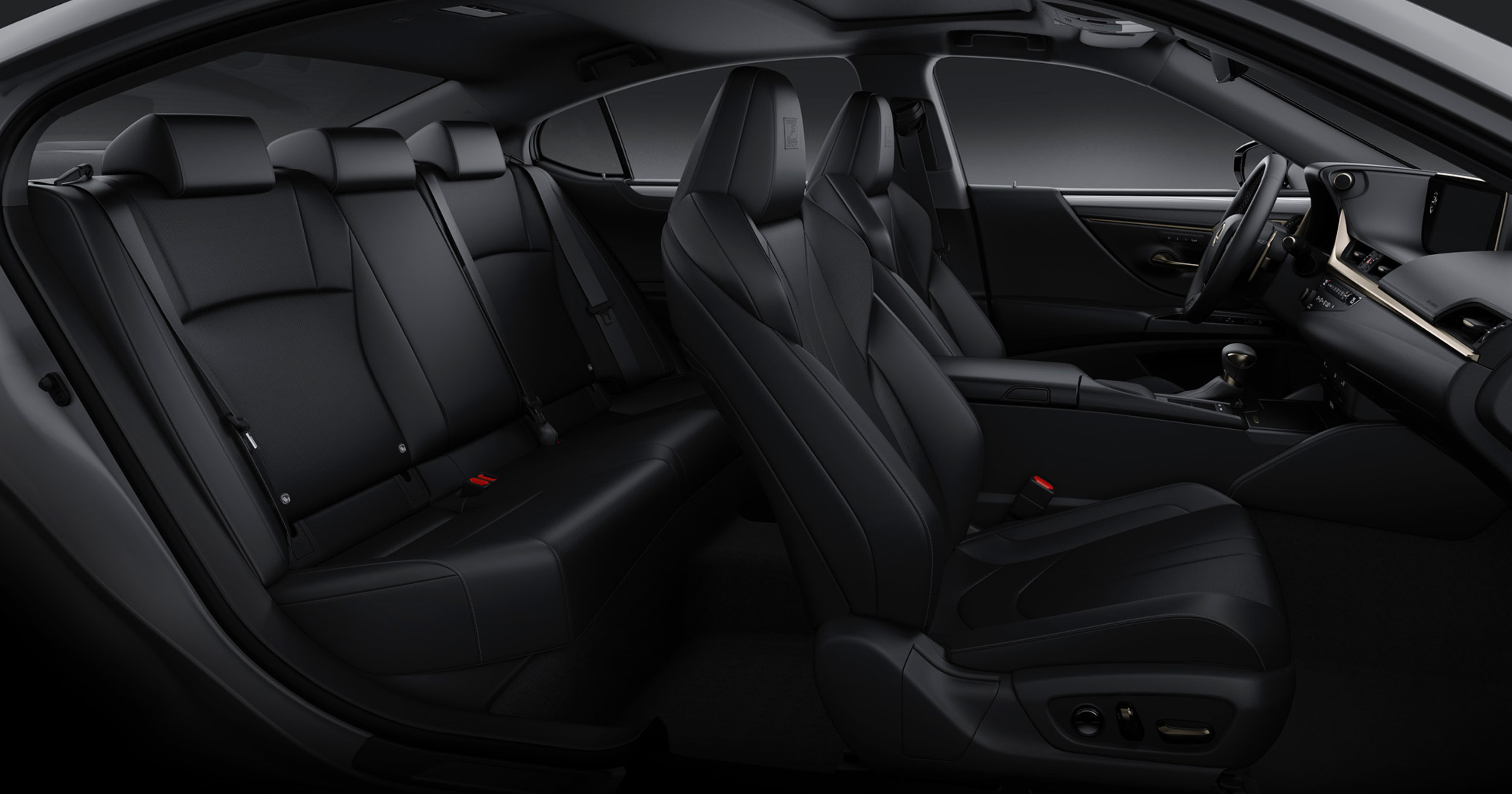
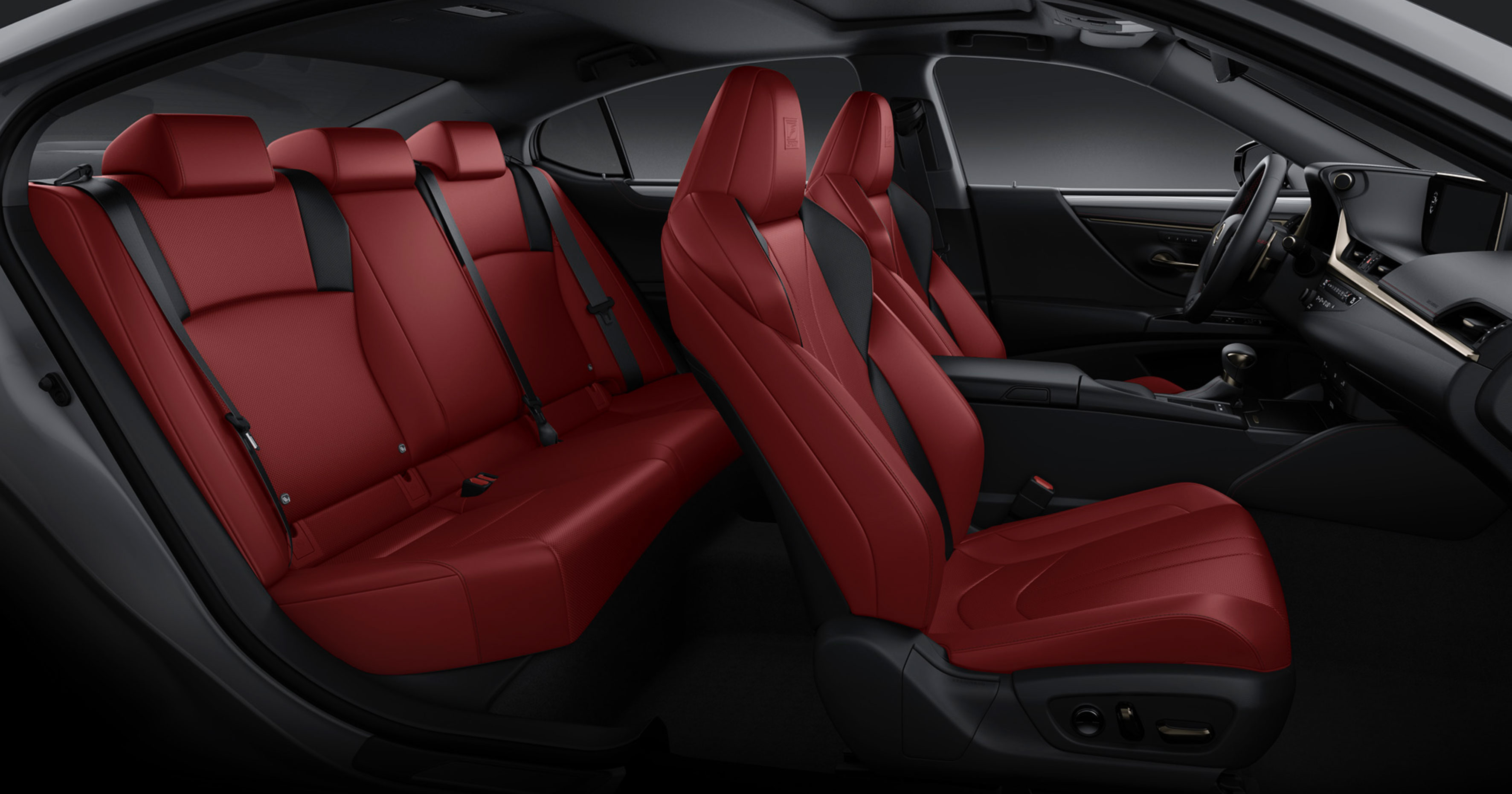
Also exclusive to the ES F SPORT is the Hadori aluminum trim, inspired by the polishing technique used on Japanese katana blades:
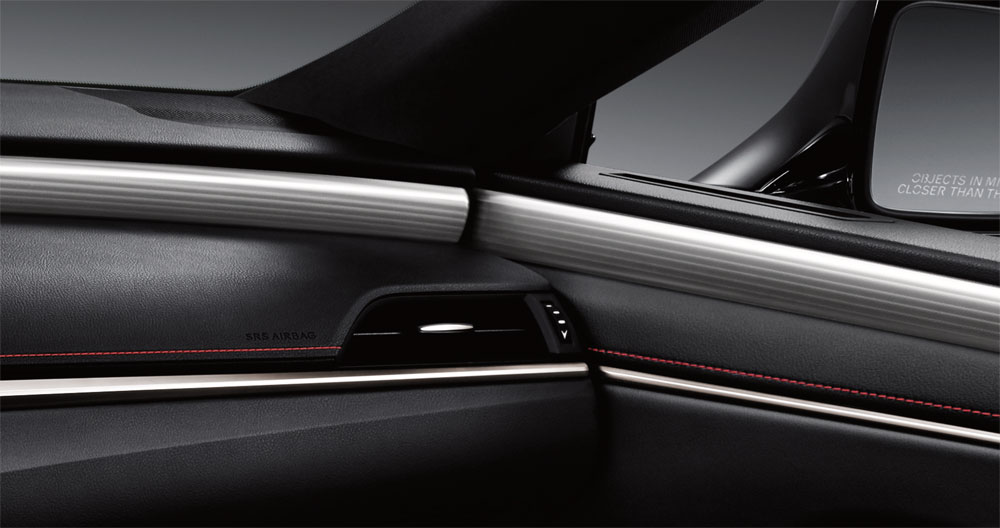
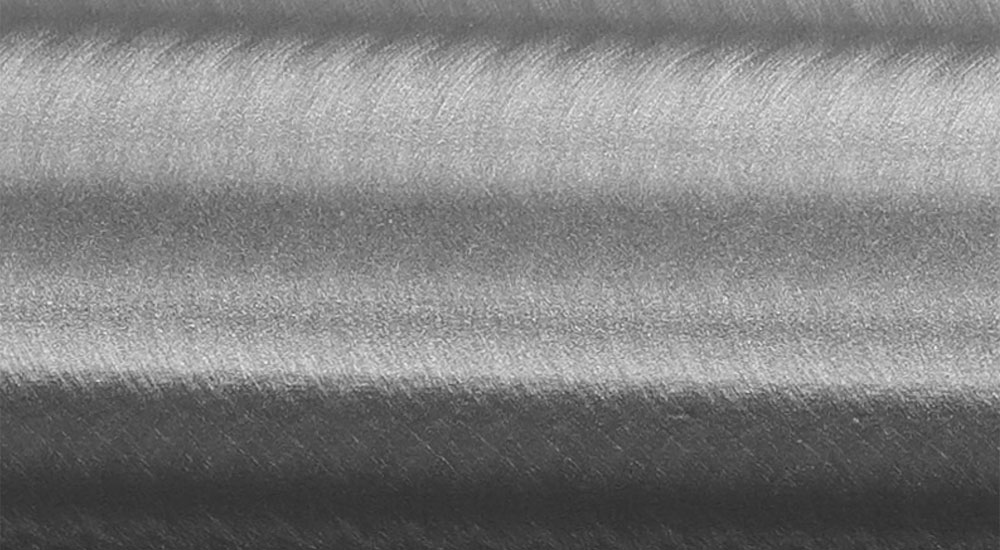
Packages
There will be four packages available — Premium, Luxury, Ultra Luxury, and F SPORT:
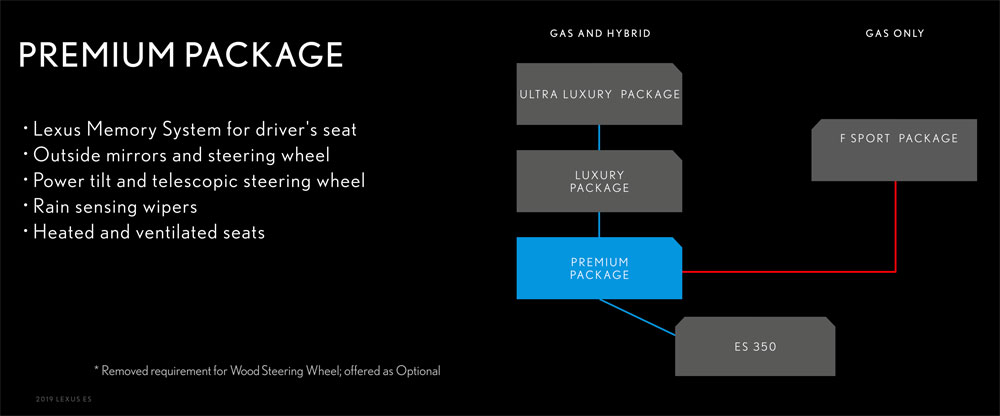
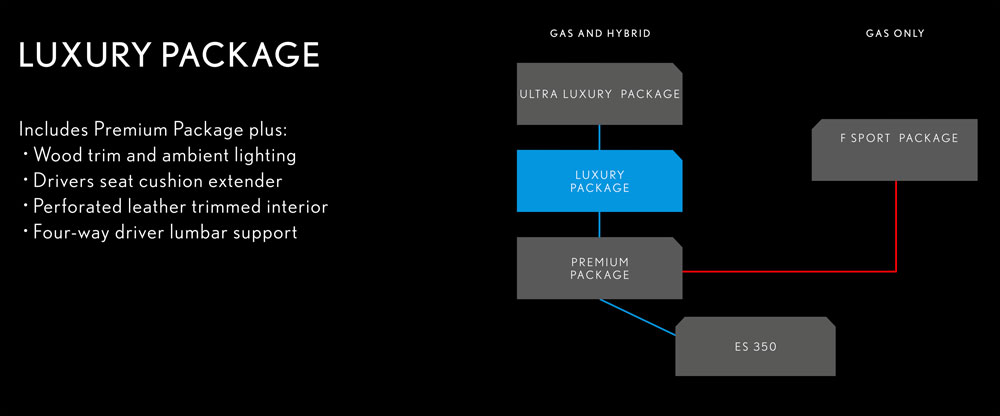
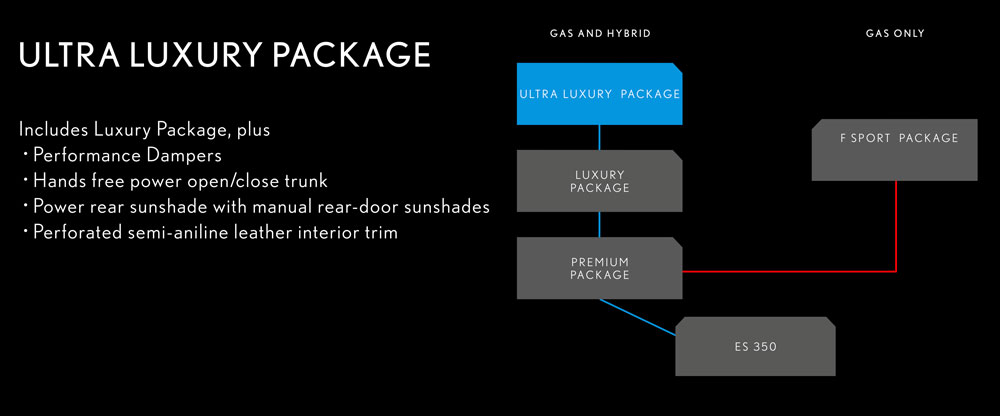

Individual Options
• Wood-trimmed steering wheel • Heated wood-trimmed steering wheel • F SPORT steering wheel (F SPORT only) • F SPORT steering wheel with heating (F SPORT only) • Adaptive Variable Suspension (F SPORT only) • Wood interior trim • Panoramic sunroof • Hands free power trunk lid • Triple beam LED headlights with Adaptive Front lighting System (AFS) • Power rear sunshade • Head Up Display • Mark Levinson audio • Navigation (12.3-inch display) • Navigation + Mark Levinson audio • Qi wireless charging pad • Blind spot monitor • Park assist sonar • Park assist sonar with pedestrian detection and panoramic view monitor • 18-inch wheels with machine finish • 18-inch noise reduction wheels with hyper chrome finish

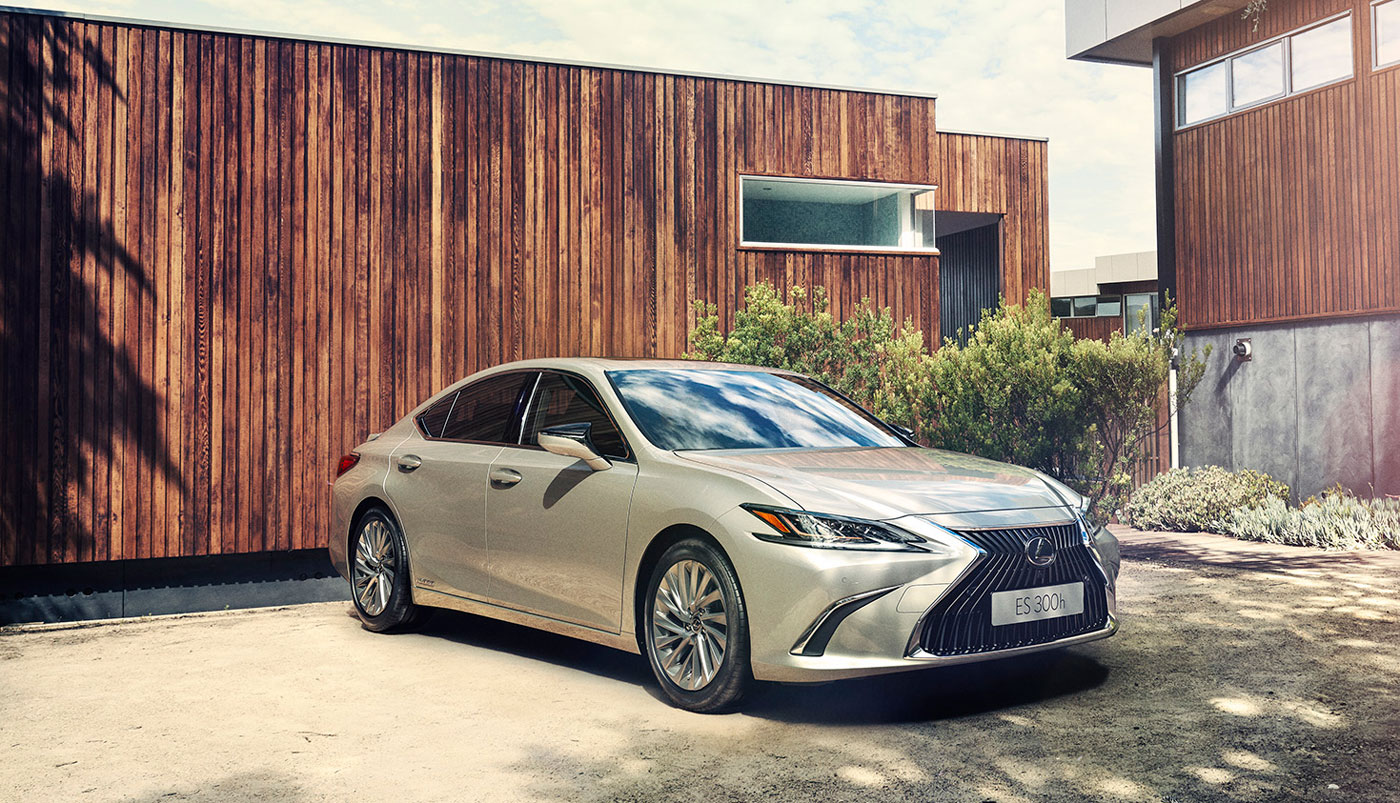
Comments